STRONG FOUNDATIONS

Planning, Purchasing, & Protecting Play and Recreational Surfacing


Planning, Purchasing, & Protecting Play and Recreational Surfacing
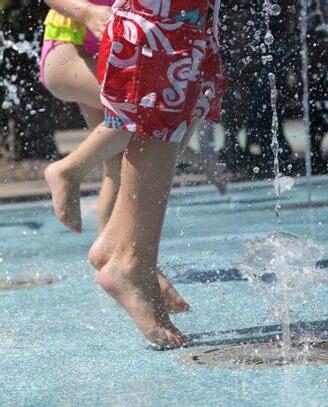



Walt Henderson
President,Henderson Consulting and Co-Chair ASTM F08.63 Sub-Committee
Teresa B. Hendy, CPSI President, Site Masters, Inc.
Jennifer Skulski
President,Skulski Consulting LLC
The purpose of this resource is to provide an educational overview and to raise awareness about some considerations for planning, purchasing, and protecting safety surfacing; it is not to be considered as an allencompassing list. Please refer to the manufacturer specifications and warnings, supplied with the product purchased, and continue with normal inspections. Safety goes beyond these comments, requires common sense, and is specific to the play and recreational environment involved. While the intent is to provide general information about safety surfacing, PlayCore, its companies, and contributors to this work disclaim any liability based upon information contained in this publication. PlayCore and its divisions provide these comments as a public service in the interest of safety while advising of
Ever since playgrounds were developed in American cities as a reaction to the industrialization of America, people have been concerned with playground safety. In those days, playgrounds were often large metal contraptions resembling gym equipment, often 15-20’ above ground.1 Surfacing, when given consideration, generally consisted of sand, screened cinders, and clay, or combinations of the above, which were rolled until packed solid.2
By the 40’s and 50’s asphalt was by far the most popular choice. No distinction was made between general play areas and areas under equipment.
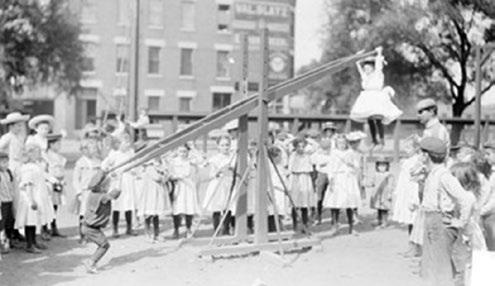
In 1969, the Committee on Accident Prevention of the American Academy of Pediatrics met to prepare voluntary standards for playgrounds. The draft was sent out to members for comment, but it was not adopted, and the effort was abandoned in 1971.
By the early 50’s both the Firestone and Goodyear Companies respectively created rubber powder and pelletized rubber for the playground, which was installed at a 3/8” depth. Though it did not likely provide adequate fall attenuation, it did set the stage for the development of more effective rubber surfaces in later years.
In 1972, the FDA Bureau of Public Safety issued a report “Public Playground Safety” revealing a dismal picture of playground hazards.
By 1978, The National Electronic Injury Survey System (NEISS) had issued its study of playground injuries treated in U.S. hospital emergency rooms, which indicated that the majority of serious injuries were the result of falls from equipment.
In 1976, the National Recreation and Park Association (NRPA) submitted a draft of a standard to the U.S. Consumer Product Safety Commission (CPSC) that contained a section on “Surfaces Under Equipment” to which the CPSC recommended additional research.
In September 1986, the American Society of Testing and Materials (ASTM) F08.52 held an organizational meeting for a task group on playground safety. The task group eventually became the ASTM F08.63 Subcommittee on Playground Surfacing Systems. CPSC staff provided input to the new subcommittee by participating in round robin testing (1988) and supporting the evolution of F355 Test Method for Shock-Absorbing Properties of Playing Surface Systems and Materials, into ASTM F1292, Standard Specification for Impact Attenuation of Surfacing Materials Within the Use Zone of Playground Equipment.3
In 1990, CPSC staff published a report on impact attenuation of playground surfacing materials for seven loose-fill materials. This work was used in the development of a table of critical heights of these materials.5

In 1998, the National Program for Playground Safety (NPPS) provided data to the CPSC staff that yielded consistently higher critical heights for materials. One of the primary differences in the NPPS-sponsored testing was the use of a larger box to contain the loose-fill materials. CPSC staff concluded that box size, material handling and instrument set-up were variables that affected attenuation test results.
The resulting efforts of a subcommittee task group from the 1998 study produced a significantly revised standard in 2004. The new standard addresses all of the issues raised by CPSC staff in addition to many other issues raised by the task group in examining the standard.5 Today, all states follow one or both of these guidelines as a standard of care for public playgrounds.

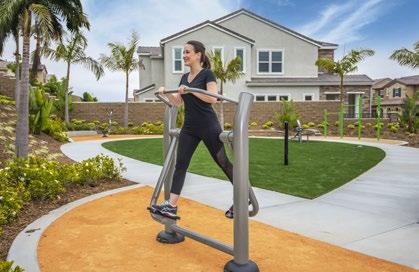
Choosing a protective surface for play areas is one of the most important decisions a playground owner will make in efforts to provide a safer play environment and reduce the likelihood of life-threatening head injuries.
Historically, protective surfacing for the earliest playground equipment was often an afterthought. As public playgrounds have evolved over the last 40 years, the National Program for Playground Safety (NPPS) cites falls to the surface as a contributing factor in 79% of all playground injuries. Research on injuries, impact attenuation, and surface materials has led to a greater variety of surface options available today. While some injuries from falls, like broken bones, may occur no matter what playground surfacing material is used, an effective shock absorbing surface can reduce the likelihood of a serious head injury.
Research and technological advancements have led to a variety of new options available for play and recreational site owners, and improved standards for surfacing to help protect adults and children at play across diverse recreational settings, enhancing the user experience, visual aesthetic, and space function.

It is vitally important that all playground equipment have impact-attenuating (protective) surfacing under and around it. Use of appropriate impact-attenuating surfacing materials in the use zone of playground equipment can reduce the risk of fall-related injury. Fitness equipment may need protective surfacing based on its intended usage. In aquatic environments, it is suggested to adequately provide specific surfacing for wet areas. The risk of life-threatening head injuries is reduced when appropriate surfacing materials are installed regardless if it’s a playground or any other play or recreational area.
Equipment manufacturers and suppliers of surfacing are responsible for providing the critical height rating for their materials. In addition, the manufacturer should supply the fall height of the play or fitness equipment.
The fall height of a piece of equipment is the distance between the highest designated play or recreational surface and the protective surface beneath.6 In addition to selecting surfacing materials based on aesthetic designs, play value, budget, and maintenance requirements, administrators of the play or recreational space should ensure that the surface they choose conforms to specified standards for both impact attenuation and accessibility. The following overview of the standards can be a valuable reference.
This guide is to be used to assist the playground owner/operator, specifier, designer, etc., in determining the properties that can be considered with regard to the protective surfacing in the playground. It is the intent to outline the requirements associated with design, installation, and maintenance of the surface. This is not a technical document and technical information must be found in the various standards.
This specification outlines impact attenuation performance requirements for playground surfaces and surfacing materials and provides a means of determining impact attenuation of playground surfaces. The lab and field test protocol simulates the impact of a child’s head with the surface.
Testing using the methods described in ASTM F1292 will provide a measured “critical height” for the surface. The height can be considered as an approximation of the fall height below which a lifethreatening head injury would not be expected to occur. The test method quantifies impact in terms of g-max and Head Injury Criterion (HIC) scores. G-max is the measure of the maximum acceleration (shock) produced by an impact. The HIC score is an empirical measure of impact severity based on published research describing the relationship between the magnitude and duration of impact accelerations and the risk of head trauma. The standard includes procedures allowing surfacing materials to be performance-rated before installation and for installed surfacing materials to be tested for conformance with the specification.
Always check for the most current version of all standards as they might have been updated to comply with industry changes. As standards are updated, numbers are added at the end of the standard to indicate the year of the latest update.
The purpose of the specification is to reduce the frequency and severity of fall-related head injuries to children by establishing a uniform and reliable means of comparing and specifying the impact attenuation of playground surfaces. Its use offers a means of objectively assessing the performance of surfacing materials under and around playground equipment and of evaluating the associated injury risk. This specification establishes minimum performance requirements for the impact attenuation of playground surfacing materials installed within the use zone of playground equipment. It establishes an impact attenuation performance criterion for playground surfacing materials, (expressed as a critical height) and procedures for determining the critical height of playground surfacing materials under laboratory conditions. The specification also establishes a procedure for testing installed playground surfaces in order to determine whether an installed playground surface meets the specified performance criterion. It is important to note that the impact attenuation specification and test methods established in this specification are specific to the risk of head injury.3
This guide covers information with regard to the design, manufacture, installation, and maintenance specific to PIP playground surfaces. When choosing a PIP surface for your playground, this guide should be reviewed to understand matters relating to installation, technique, performance, and warranty of such surfaces.8

The goal of this specification is to establish a uniform means to measure the characteristics of engineered wood fiber (EWF) in order to provide the potential buyer with performance specifications to select EWF. It establishes minimum characteristics for those factors that determine particle size, consistency, purity, and ability to drain.9
This specification establishes minimum characteristics for those factors that determine accessibility. It applies to all types of materials that can be used under and around playground equipment and was developed to address this need for quantifiable measurement of accessibility for persons with mobility impairments who may also use assistive mobility devices, including but not limited to wheelchairs, crutches, and walkers. The test methods in this specification address access not only for children but also for adults who may traverse the surfacing to aid children who are playing. The protocol described within the standard measures the work force for a wheelchair — straight propulsion and 90 degree turn over a surface. The surface may be acceptable if the work force is less than the average work per foot values on a hard, smooth surface with a grade of 7.1 +/- 0.2% (1:14). This test is most often completed in the lab with a surface sample. Therefore, it is important for the test to be administered in the field following installation of the playground surface.10
This specification covers test methods and performance requirements for loose-fill rubber playground-surfacing products and is intended to complement existing ASTM International Standards for determining the shock attenuation and accessibility of a playground surface. The objective of this specification is to assist playground designers and specifiers, owner/operators, and playground-surfacing suppliers in evaluating loose-fill rubber products for playground use.11
This specification provides safety and performance standards for various types of public playground equipment. Its purpose is to reduce lifethreatening and debilitating injuries for children aged 2-12. It includes standards for playground equipment as well as dimensionally defines use zones under and around equipment and fall heights of components.12
This specification provides safety and performance requirements for various types of public use play equipment such as, but not limited to, composite play structures, climbing structures, to-fro swings, spring rocking equipment, and slides. The purpose of this specification is to reduce potential life threatening and debilitating injuries in children aged 6 months to 23 months. This standard also dimensionally defines use zones under and around equipment and fall heights of components for this age range.13
This specification establishes parameters for the design, manufacturing, installation, and other practices for outdoor adult fitness equipment. This comprehensive safety standard is written for equipment that is used by people of a minimum age of 13 in unsupervised settings. This standard, along with the equipment manufacturer’s recommendations, cover surfacing requirements and dimensions for outdoor fitness equipment.14
Some play and recreation elements that are located at ground level do not require the user’s feet to leave the ground, and do not have a fall zone, do not require impact-attenuating surfacing. Examples of this type of play and recreation equipment include sand areas, activity panels at ground level, play houses, benches, pushup stations, and dog park areas. Please refer to the manufacturer specifications and requirements for surfacing under ground-level equipment.

IPEMA helps ensure that installation and maintenance processes for playground surfacing materials are compliant with ASTM F1292 and other applicable standards. In the interest of public playground safety, IPEMA provides a third-party certification service whereby TÜV SÜD America validates a manufacturer’s conformance to certain ASTM standards. Their website provides a list of products and companies that have met these standards, to help customers ensure the products they purchase are compliant. IPEMA also provides a variety of additional resources pertaining to playgrounds and surfacing which can be obtained through the IPEMA website at ipema.org.
A distinction needs to be made between IPEMA membership and the IPEMA certified product manufacturer designation. An IPEMA membership is open to manufacturers of equipment and surfacing as well as to other individuals interested in promoting play and recreation who are involved in the play and surfacing industry. On the other hand, IPEMA certification is only given to a participant’s product(s) when they conform to certain ASTM standards. If the product is certified, IPEMA provides a product(s) seal to participants. If members do not wish to participate in the certification program, they may not use the IPEMA certification seal. Always check with the manufacturer regarding their IPEMA certified products as these may vary by manufacturer.
The CPSC handbook presents safety information for public playground equipment in the form of guidelines to promote greater safety awareness among those who purchase, install, and maintain public playground equipment. Because many factors may affect playground safety, the U.S. Consumer Product Safety Commission (CPSC) staff believes that guidelines, rather than a mandatory rule, are appropriate. These guidelines are not being issued as the sole method to minimize injuries associated with playground equipment.


The Americans with Disabilities Act (ADA) is a federal civil rights law that prohibits discrimination on the basis of disability. Public playgrounds are covered under the ADA, such as those owned or operated by units of state or local government (Title II) and places of public accommodation (Title III) like at malls, restaurants, theme parks, fitness centers and resorts. The 2010 ADA Standards for Accessible Design establishes enforceable minimum design standards for public playgrounds and maintenance requirements for the accessible route to accessible play components. The accessibility standards address the complete route of travel to and throughout the recreation space to ensure that users are able to navigate comfortably throughout the entire recreational experience. Surfacing suppliers should provide site owners with detailed information on the installation and maintenance of the surfacing products to comply with the 2010 ADA Standards. While ASTM F1951 provides a specification to determine accessibility of surface systems under and around playground equipment, playground owners should conduct a field test following installation to ensure the surface is compliant with ADA standards. A field inspection includes checking for slope and cross slope with a digital level; openings and changes in level with a tape measure; and firmness and stability with a rotational penetrometer or instrumented surface indenter. (See the sample checklist on pages 55-56.) For more information about site planning, purchasing, and installation to meet ADA guidelines for compliance, refer to the U.S. Access Board technical guide “Surfacing the Accessible Playground: 7 Things Every Playground Owner Should Know About the Accessibility of Their Playground Surfaces” at www.access-board.gov.
The Commission believes that the recommendations in the handbook along with the technical information in the ASTM standards for public playgrounds will contribute to greater playground safety.






Included in the publication are ASTM testing methods, lists of appropriate and inappropriate surfacing materials, and helpful information for both unitary and loose fill surfaces. 6 Copies of this standard can be obtained through the CPSC website at www.cpsc.gov.

Play and recreation are the foundation for learning. They are a critical component of healthy communities and the physical, social, emotional, and intellectual development of children. Through child-centered free play, children develop fine and gross motor skills, communication and language skills, and engage in activities that promote executive functioning and cognitive skills. Providing opportunities for various types and forms of play such as dramatic, cooperative, and constructive play nurtures a child’s individual learning style and increases their learning potential. It is essential that children and families are provided with opportunities to engage in meaningful play and recreation experiences that enrich their lives and create lifelong memories. Providing users with compliant play and recreational environments will allow them to be as physically active as possible while growing healthy and strong, and in turn positively affect families and communities.
Play value can be described as how play affordances are read in the environment, which motivates and reinforces play and recreation. Surfacing offers a vast array of opportunities to infuse play value into the overall design of the environment. It can promote meaningful play and recreation experiences, provide multisensory features, and transform the playscape to encourage creativity, imagination, and bring playful learning, physical activity, and socialization outside. Playground equipment is often selected based on perceived play value, innovation, and developmentally appropriate activities. The same criteria should be taken into consideration regarding surfacing options and features that can be strategically included to increase the overall play value and increase the user experiences of any outdoor environment.


Surfacing design can be maximized by utilizing several types of surfacing within a play or recreational area. In addition to color, the varying textures can enhance the overall design, promote sensory rich play experiences, enhance imaginative play, and encourage movement and exploration. Varying the surface materials can also provide aesthetic appeal and organization of the space.
Many color options exist when considering unitary surfaces such as poured-in-place rubber, tile, or loose-fill material. Using an assortment of colors can help visually organize a play environment so that it is easier to understand and navigate. Colors can provide visual cues and contrast around swing or slide exits to reinforce where active areas are located and to alert visitors to proceed with caution. Color often is used to create visible pathways or landscapes throughout the environment, enhancing the overall aesthetic appeal. Using designs or shapes in assorted colors can lead to spontaneous play behaviors as children develop their own games and have opportunities to reinforce learning outdoors in fun and creative ways.
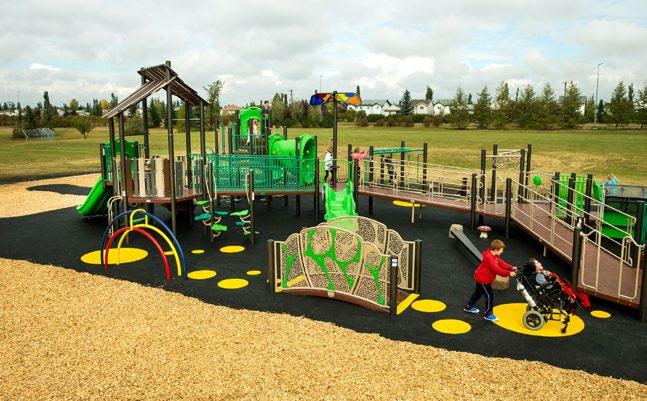
Portable materials or “loose parts” support and stimulate spontaneous and creative play, and are critical components of playgrounds, fitness areas, or multipurpose environments. Loose fill surfacing materials such as EWF can bring natural loose parts to the play and recreational environment that individuals can enjoy by using in imaginative play. Sand, gravel, or EWF used around PIP can provide a multisensory experience as children use tools to construct and experiment with the material. Creating planting pockets outside use zones and naturalized playgrounds that use child-friendly plants can also provide play experiences and loose parts for children to engage in dramatic play and recreation activities.


Themes can be dramatically carried out through surfacing designs, transforming the play and recreational environment into practically anything from a life size board game to a baseball field, or even an ocean surrounding a ship. Creative theming can make a play and recreational environment special and unique and often becomes the identifying factor of the location. Themes can promote dramatic play, encourage physical activity, prompt spontaneous games, and bring learning outdoors. Communities can apply themes through custom surface designs that relate to their local history, environment, and culture, or utilize contrasting color inlays to add logos that recognize a donor or sponsor.
Schools, early childhood centers, and parks are often looking for ways to bring fun learning opportunities outside for hands-on experiences and to promote engagement between children and adults. Consider the following examples as you think about ways to utilize PIP and tile surfacing designs to promote learning and reinforce academic skills.
Math: tic-tac-toe, hopscotch, numbers, objects to count, various sizes, shapes, measurement
Literacy: sight words, functional signs, object identification, alphabet
Social Studies: maps, cultural/community history, weather
Science: footprints, animals, leaves, lifecycles


Children need opportunities to learn how to cooperate, understand sportsmanship, and to follow rules of a simple game or activity. PIP and tile surfacing can offer exciting ways to incorporate favorite childhood games such as leap frog or four square, and it can help designate areas for activities that encourage physical activity such as trike paths and sprint areas where individuals can run, skip, hop, or move with their mobility device to the “finish line.”
Including auditory sound in an environment will enhance the hands-on experience and promote socialization among children, families, and others. Consider including musical instruments in your installation to promote these activities. While protective surfacing may not be required for musical instruments at ground level, it is suggested to have some type of surfacing that will enhance the aesthetic appeal of the overall design, providing yet another sensory experience beyond sound. These spaces are usually located adjacent to the playground adding opportunities to the development and multigenerational play value of the overall environment. Surfacing in these areas can be used to provide routes of travel, designate recreational areas, create a “dance floor,” and enhance creativity. Musical elements such as piano keys or musical notes designed in the unitary surfacing can offer sensory rich experiences for people of all ages and abilities.


Elements such as hills and mounds can increase the play value of an environment by providing new points of view for discovery, physical activity opportunities for both children and adults, and changes of topography to enhance the overall design of the space. Children will be able to climb the hills and use the inclination to roll down the surface, increasing physical activity. In addition, slides can be built into the hillside, taking advantage of the existent topography. These changes in topography can also be designed to complement fitness zones by offering other cardio opportunities adjacent to the equipment. Ease of maintenance will depend on the size, steepness, and surfacing material used. Surfacing manufacturers will be able to recommend the best type of surfacing for the space and slope.
Along trails or in designated areas, outdoor adult fitness spaces can enhance the overall design of the environment. These areas can be found along trails, in clusters, or alongside a playground area, rehabilitation facility, or university. Including fitness opportunities in the area will allow for the users to promote physical activity, improve mental well-being, and help promote health and wellness. Surfacing will be an important part of these spaces as protective surfacing is required for some equipment. In addition, designs can be incorporated into the surfacing to further extend exercise opportunities. Some examples include dot drills, long jump markers, sprint measurements, and agility ladders, all which can be added to many types of surface by using contrasting colors.

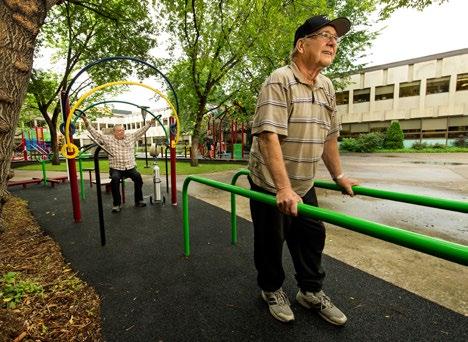
Creating interesting experiences along accessible routes of travel is another strategy for encouraging both children and adults to be more active in the recreation environment, increase connectivity of the site to the surrounding neighborhood, and expand the appeal of a park and location. The primary routes of travel should meet the accessibility standards and be properly maintained to ensure individuals with mobility impairments can traverse the surface. Designing interesting routes with sinuous curves, color enhancements, and texture can help bring additional interest as users are encouraged to move and explore.

Installing appropriate surfacing across a variety of settings can help enhance the environment as well as activate the space for the community, provide safety for the users, and enhance the visual aesthetic and appeal. There are a wide variety of sites that can benefit from responsible and creative surfacing applications.
Playgrounds need surfacing that is impact attenuating for accidental falls, but the surface can also be utilized to add fun, visual appeal, and activities to the space. Fun colors, textures, and visual cues can help enhance the environment. For play spaces, surfacing should meet the specified safety guidelines and accessibility standards while also playing a valuable role in design, aesthetics, and play value.
While these environments are most frequently seen in parks and recreation facilities, they can also be found in many other public spaces. These spaces will need to meet specified safety and accessibility requirements as per ASTM F3101 and ASTM F1292. Work with a manufacturer that specializes in fitness parks who can guide you in the process of installing protective surfacing to benefit the users and the space.
Fifty years ago, dry recreational environments evolved from abrasive, hard concrete, asphalt, or dirt toward alternative safer, engineered surfacing materials. Today, spray parks, water playgrounds, pool decks, and other aquatic recreational accommodations are beginning a similar evolution. Traditional surfaces for splash parks include brushed concrete, painted or coated concrete, cement pavers, or tiles. The major disadvantages of traditional finishes are that they can be hard, abrasive, or slippery. Manufactured surfaces can be applied over concrete or other substrates to substantially increase the performance of the wet play area. While there are no specific standards and guidelines for aquatic play areas, ASTM F2223
– The Standard Guide for ASTM Standards on Playground Surfacing can be a valuable resource for guiding expectations in these environments.
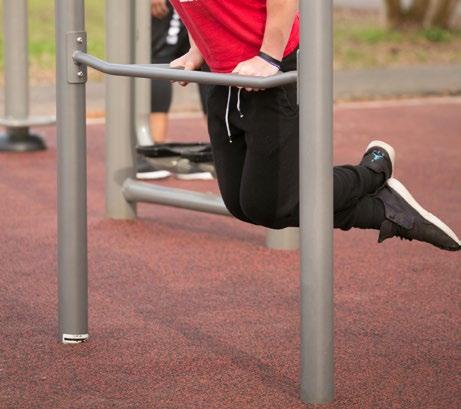
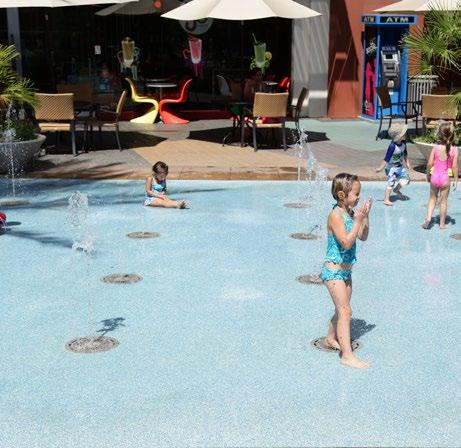
Today, dog parks can be found across a variety of settings to meet the diverse goals of each community. While dog parks have been common in parks and recreation locations, it is a growing trend in other settings that wish to accommodate dog owners and their pets. Increasingly, dog parks can be found in locations such as corporate settings, hotels, RV parks and campgrounds, airports, rest areas, restaurants, and housing complexes. While there are no specific standards or guidelines for these areas, it is always recommended to use appropriate materials. A variety of surfaces can be used in dog parks. Choose a manufacturer that specializes in surfacing for these environments and proactively plan a maintenance plan that preserves a clean environment.


Trails may be designed to promote connectivity and incorporate interesting routes of travel to and throughout an environment. Accessible trails or trail segments should be designed utilizing the accessibility standards and best practices for greenways. Surfaces should be stable and firm, free of gaps, extreme changes in level and protruding objects, or overhead obstructing objects. Accessible trails can encourage community connectivity, exploration, and physical activity. Some settings offer primary and secondary pathways as another design strategy to encourage movement and incorporate attenuating materials.
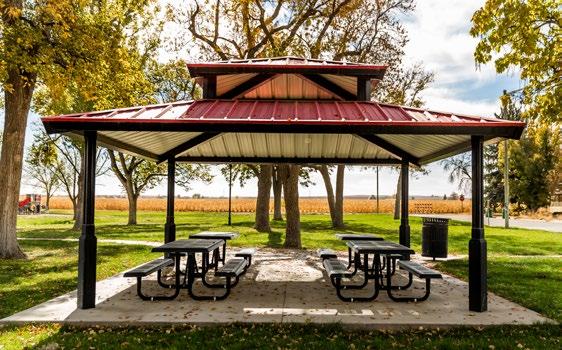
Interesting and innovative designs can be incorporated into commercial and private landscapes through the use of surfacing materials. From hospitality to multi-family housing or public spaces, surfacing materials can provide aesthetic touches to promote the intended use of the space. Synthetic grass provides appeal and lower maintenance to an open area. EWF can be used to create paths or to frame natural elements such as plants and/or shrubs, and help them retain moisture, which may reduce the need to water. Shredded rubber can provide colorful visual interest, and a combination of materials can bring attention to a particular space by playing with different colors and textures to provide visual cues. In addition, surfacing could potentially decrease maintenance cost while providing a durable and beautiful landscape.

Picnic areas can also be greatly enhanced by designing appropriate surfacing in harmony with the amenities. Utilizing a firm, stable surface to and around picnic seating areas helps ensure accessibility for people with mobility impairments. Colors can be incorporated to denote activity areas. Surfacing can also be used to create activity zones for games like horseshoes, lawn bowling, and cornhole. It is important to think of the picnic area and its supporting amenities when designing the space so that a continuous accessible route connects the picnic shelter to various seating options, grills, drinking fountains or water faucets, restrooms, games, and other active areas within the picnic space.
Multiuse recreational areas may include a variety of the aforementioned settings in a multigenerational, activity-rich space. In these environments, playgrounds, dog parks, multipurpose fields, trails, and aquatic facilities may be present to serve the wide-ranging interest of the community. While designing these areas, work with an experienced supplier that will provide surfacing suggestions, recommendations, and will help design an environment with enjoyment and safety in mind. Many innovative designs can be accomplished by utilizing different types of surfacing materials that will also increase usage, provide visual cues, guide the users through the activity areas, and enhance the overall experience and environment.

Depending on the form and function of your play or recreational area, there are a number of choices you can make in regard to surfacing. The budget, the amount of use the playground or recreational area gets, your ability to maintain the surface, and other factors will help facilitate playground and recreational area surfacing selections. Be sure to follow safety and accessibility guidelines. Playgrounds should always provide protective surfacing. Be sure to ask the supplier for specifications, warranty information, and maintenance guidelines, as they may vary by brand.
Surfacing should meet appropriate guidelines, be readily available in your area, and meet the play or recreational area needs for durability, drainage, and accessibility. Consider climate, maintenance cost, and other variables before choosing. Your supplier can help decide what is most appropriate for each condition.
Surfacing options for playgrounds are generally divided into two categories: loose-fill and unitary. These options can be combined in a variety of ways or used alone.
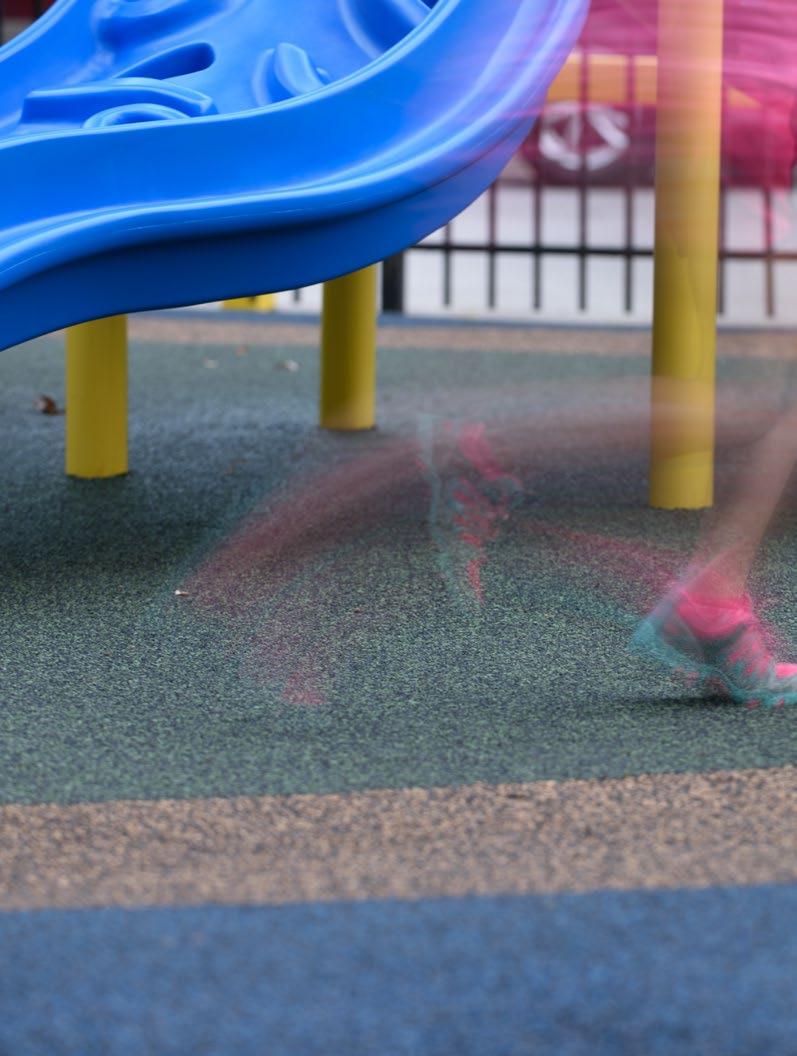


When impacted, loose-fill materials move downward and/or outward, providing excellent fall cushioning but also require ongoing raking and replenishment to keep the materials in place at an appropriate depth. Loose-fill materials need to be installed by using earth berms, timbers, plastic edging, or concrete curbs to contain the materials. Rubber wear mats should be placed in high impact areas, such as under swings and the base of slides. These are areas more susceptible to displacement.
The CPSC classifies loose-fill materials as organic or inorganic. Organic loose-fill material will compress at least 25% due to use and weathering.8 Loose-fill material should be avoided for play areas intended for toddlers or dogs as this material can pose a danger of ingestion.
EWF is defined as wood ground to a fibrous consistency. It is different than wood chips or garden mulch in that there is a requirement stated in ASTM F2075 for particle size distribution and purity, which allows the product to “knit” together creating a stable surface for mobility devices. When installing EWF, it is recommended to utilize a layer of gravel for drainage. The next layer should be a geotextile cloth. On top of that should be a loose-fill layer meeting the specifications and fall height requirements of the environment. EWF surfacing should also meet ASTM F1951. This can be accomplished by installing the material to manufacturer’s installation instructions, otherwise, it may not meet accessibility standards. EWF surfaces are better suited for playgrounds, landscapes, and trails.
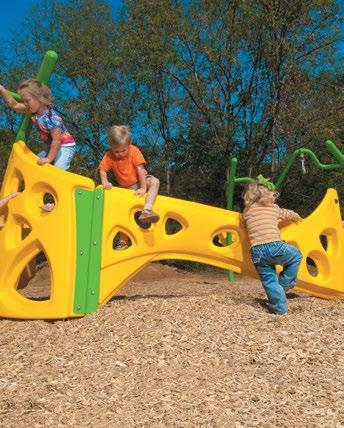
EWF is the most widely used playground surfacing, approximately 75% of the market uses this budget-friendly choice.
EWF is not mulch, wood chunks, or bark chips. It is a product specially engineered for the needs and specifications of the playground industry.
Wear mats are recommended under swings and at slide exits to reduce raking maintenance.
It is generally installed over a gravel or piped drainage system with a filter fabric that is placed between the fiber and the drainage system to prevent clogging and to avoid material compaction caused by standing water.
Since it is a natural material subject to decomposition, it requires periodic “topping off” to maintain the depth required for adequate fall attenuation.
Compared to unitary rubber surfaces, EWF is more difficult to traverse with mobility devices.
It has a relatively low initial cost.
In cases where the budget is limited, choosing EWF may allow you to invest more of your funds into equipment.
It can be installed by a volunteer crew, which can save money over professional installations.
Meets ADA guidelines when properly installed and maintained per the manufacturer’s instructions and IPEMA
EWF provides an attractive, natural look and provides natural loose parts play.
Loose-fill rubber offers the best impact absorbing properties of all the loose-fill surfaces. Check with your supplier for their specification and be sure to ask for their accessibility testing results. Loose-fill rubber is best suited for playgrounds, landscapes, and trails.
Rubber chunks are available in a variety of colors
Best ASTM F1292 test results
Made from recycled materials
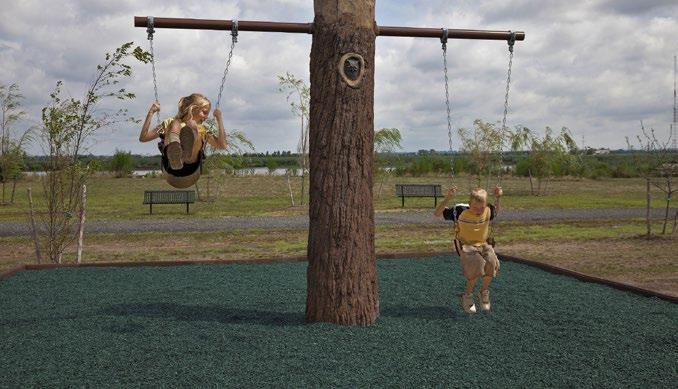

Good “green” alternative for playground surfacing
Drains well
Mold, animal, and insect resistant
Does not freeze in cold climatic conditions
It will not decompose or be subject to fungal issues, saving money and maintenance
It can be installed by volunteers if desired, saving the customer money over professional installations
Might qualify for environmental grants
Although considered as a “loose-fill” surface, these materials seldom meet the accessibility standards or ASTM F1951. The surface materials may be used to provide tactile experiences on secondary routes. However, the drawbacks to the surface materials should be carefully considered. Sand can become heavy and concrete-like in wet conditions, thereby reducing its ability to attenuate falls. Pea gravel may potentially be a choke hazard for children or even dogs. Frequent raking and turning can help with their tendency for compaction. CPSC states that sand and gravel are generally used as landscaping-type material that can be layered to certain depths and resist compacting.
Unitary products include poured-in-place rubber (PIP), tiles, bonded rubber, and synthetic grass. Unitary surfacing does not require raking, compaction, or replenishment, however, it may require sanitization or maintenance due to surface debris, vandalism, movement in the tiles, erosion, poor drainage, or worn areas that result from repeated impacts. When unitary surfacing is in need of repair, it should be done immediately as per manufacturer’s instructions. Always consult the manufacturer’s instructions before applying any chemicals or before pressure washing. Also, consider that some dark colored surfacing materials exposed to intense sun may cause blistering on bare skin. Check with the provider of surfacing if light colored materials are available or include shading to reduce direct sun exposure.
The greatest benefits of unitary materials are less frequent maintenance, predictable cushioning properties, and that the materials stay in place. Poured rubber provides the most consistent accessibility, specifically for people who use mobility devices, and there is generally a higher initial cost. Most unitary materials require a base of compacted stone or concrete/asphalt. The cost of this base should be considered in the overall cost analysis of the surface system. See your manufacturer’s warranty information for the predicted product lifecycle.
Poured rubber or poured-in-place (PIP) is a popular surfacing choice and consists of two layers, a base layer for attenuation, followed by a colored wear layer. If attenuation properties are not required, the base layer would not need to be installed. The low density base layer is laid first and cured overnight, followed by the wear layer. EPDM, TPV, or Rubber Crumb/SBR is mixed with a polyurethane binder and poured into place at the site. PIP is to be installed over asphalt, concrete, or compacted stone. Ideally, temperatures should be between 45 to 105 degrees Fahrenheit during installation of the product; humidity should also be taken into account as it will have an effect on temperature.
Requires trained installation crews to ensure it meets safety requirements, is durable, and to help prevent failure of product
Thickness can be modified to meet varying critical fall heights within the playground
Installed on site in two layers
Needs to be installed over concrete, asphalt, or compacted stone
Prices will vary but can depend on color, size of installation, and thickness. Prices will generally increase as thickness increases and as color levels increase from all black to 100% color. Color options that mix in black granules will generally be more economical than 100% color granules. This surface requires one of the highest initial investments and may surpass the cost of the equipment as a percentage of total budget. It must also be installed by a trained professional crew. However, over the life of your playground, it will require less frequent maintenance, is not displaced during play, and is easy to clean, as litter will not mix into the product.
Poured rubber offers the greatest design options; colors can be mixed to produce varying hues, or laid side-by-side to create artistic patterns and graphic designs. Additionally, games such as hopscotch can be incorporated to add additional play value. The product is a popular choice for aquatic environments. It is also important to note the choices of urethane; standard aromatic urethanes will initially “yellow” the overall appearance of the color and is especially noticeable on lighter hues. To avoid this, be sure to specify an aliphatic urethane. PIP is best suited for playgrounds, fitness parks, landscapes, trails, and multiuse recreational areas.
A wide range of colors allows for creative designs, graphics, and themed options
Creates the best surface for accessibility by creating a seamless surface
Minimum daily/weekly maintenance consists of occasional cleaning and removing debris
Good resistance to flammability
Soft, springy feeling underfoot
“Green” option that uses recycled rubber

Needs to be installed by a trained professional to ensure proper installation
Quicker to install than PIP
Thickness varies by fall height
Needs to be installed over concrete, asphalt, or compacted stone
The shred texture does not lend itself to precise graphic design, but still provides a fun, unique, and colorful appearance to the play area
Surfacing tiles provide a single, smooth surface once installed, providing good accessibility. Tile can range from rubber tiles, vulcanized tiles, and even aquatic tiles. Some tiles are manufactured with recycled rubber, others with virgin rubber, and some may not be recycled at all. Tiles usually installed in play and recreational environments are made of recycled rubber, and are poured and molded in a controlled environment, rather than onsite as with other rubber surfacing products, so installation of the product is uniform in consistency and not subject to the site conditions or weather. Installation methods should be followed closely to ensure a compliant and durable finished product. Tiles are installed by adhering to the substrate or fastening the tile together with adhesive or fasteners. Tapered tiles are often used to provide ramp transitions from tile to surrounding substrates. Because they are not poured on site, they are often used for indoor playground environments when a solid surface is desired. Tiles are best suited for playgrounds, aquatic areas, landscapes, trails, and multiuse recreational areas.
Bonded rubber can be installed in a single color, or mixed together to create a subtle, blended shade
Minimum daily/weekly maintenance consists of occasional cleaning and removing debris
Creates a natural look
Promotes accessible routes of travel for people using mobility devices
Made with recycled rubber
Bonded rubber surfaces utilize recycled rubber that is cleaned, then dyed in a variety of colors. Bonded rubber resembles a shred in texture, and consists of one layer, which is also mixed with urethane on site before being installed. Like other unitary surfaces, it provides a great surfacing option that promotes accessibility. Bonded rubber is best suited for playgrounds, landscapes, trails, and multiuse recreational areas.
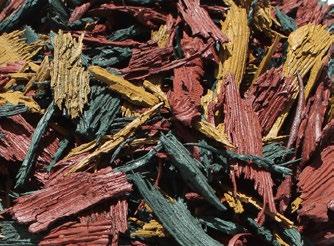
High durability
Some tiles may be available with an interlocking option
Can be used indoors and outdoors

Low-maintenance and long wear
Provides excellent accessibility for mobility devices
Durable choice for high use areas
Tiles are available in different thicknesses to accommodate various fall heights
Tiles may utilize recycled material
Easy to repair
Synthetic grass is a product designed to bring the look of nature to your environment. Synthetic grass can be optionally rolled and seamed over a shock absorbing, fall attenuation layer based on site needs. Infill can be placed in the synthetic grass to stabilize and hold grass blades upright. This product is an excellent choice when blending into the surrounding landscape. Synthetic grass can be specified to meet and exceed ASTM F1292 requirements. In addition, some manufacturers have developed synthetic grass specifically designed for dog parks. The dog park synthetic grass is tufted and textured differently from other synthetic grass to create a product that is less likely to mat down. Specialized pet systems often feature specifically coated backings that provide extra strength against wear from dog’s paws and claws. In addition, this type of synthetic grass includes a special infill that provides protection to help fight bacteria from spreading and was designed to be safe to the environment, humans, and four-legged friends alike. Synthetic grass is most commonly used in playgrounds, dog parks, landscapes, and multiuse recreational areas.
Look and feel of natural grass without the need to mow or water
Various types of cushion layers can be used to meet fall attenuation requirements
Installed over concrete, asphalt, or compacted stone
Varying densities available for varying applications
Low maintenance
Material resembles grass blades which provides a natural, realistic look and feel all year long
Dog park specific product is available

Meets ADA guidelines when properly installed and maintained per the manufacturer instructions
Appealing natural look and feel
Some variety in blade look and color may be available
Drains well and is soft and resilient
Can be customized with logos, graphics, and a variety of colors
Surface temperatures can be lower vs. other surfaces (dependent on infill selection)
Helps eliminate unsightly dead grass spots and mud pits in dog parks
Unwanted odors easily flush away with water in dog parks
Does not require chemicals, fertilizers, or insecticides to maintain its natural look and feel

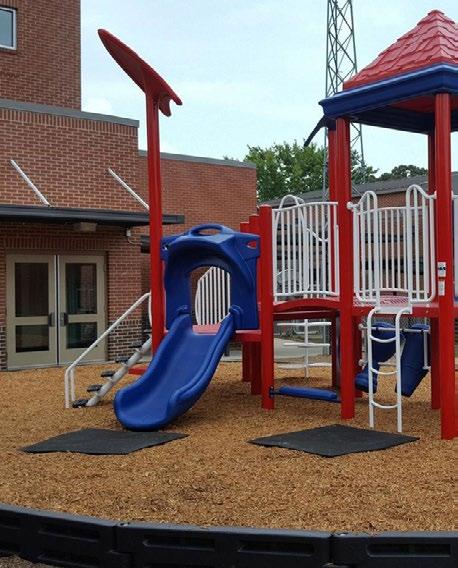
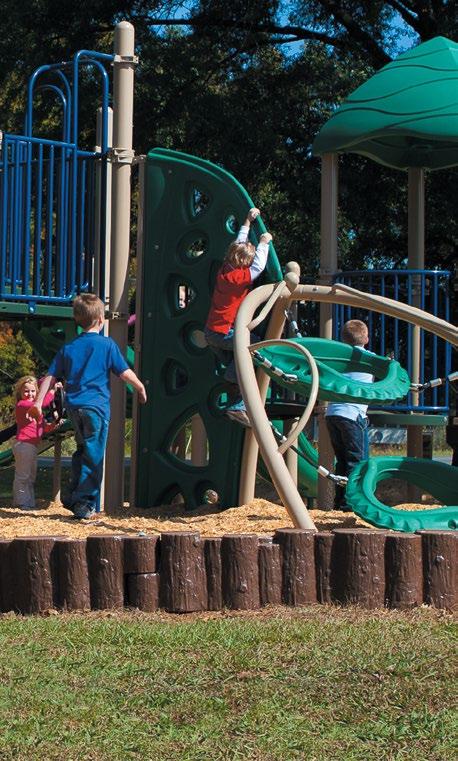
There are a variety of surfacing accessories that can be added to enhance drainage, help contain loose fill surfacing, and reduce maintenance. These accessories can improve the performance of play and recreational surfacing and help ensure continued compliance.
These heavy rubber mats help provide stability and reduce displacement of loose-fill surfaces when placed under swings, slide exits, and other components where landing, dragging of feet, or other movement is common.
Curbs are available in a variety of materials (including rubber, plastic, and glass fiber reinforced concrete) and heights to help reduce migration of loose fill surfaces outside the designated area. They can also be used to add an attractive border to the play or recreational space. Curbs are also available as an ADA accessible transition curb, which consists of a ramp designed to allow access and egress to people using mobility devices.
Other accessories include drainage systems and geotextile material designed to prevent drainage clogs and weed penetration of the surface. Geocomposite drainage systems are engineered specifically for recreation and playground areas and designed to solve groundwater and drainage issues. Ask your supplier about accessories that may be a complement to your specific site conditions and surfacing choices.
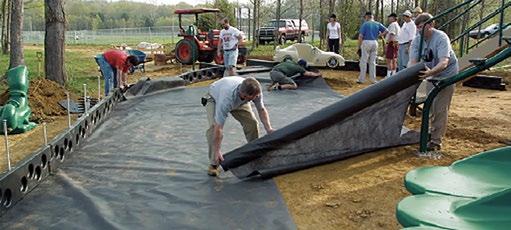

When planning your environment’s surfacing, be proactive and carefully consider your specific site needs, goals, and vision. It’s always a good idea to meet with the local community to get ideas on how they would use the space. Once you have a general idea of the surfacing you’re interested in, you can meet with vendors to discuss options, narrow your selection, focus on creating a budget, raise funds for execution, and utilize marketing to help promote the project and processes along the way.
Organizing a committee of stakeholders to help drive the project forward can be very helpful, and will help build social capital. Community engagement is possibly one of the most important aspects of any project to ensure local priorities have been addressed, so be sure to enlist community partners, volunteers, and potential funders that share your mission, values, and goals. Some communities have found it viable to organize a group of volunteers into different committees in charge of oversight, planning, steering, funding, logistics, and marketing to collaborate and build momentum while funding the project. Effective community engagement helps ensure a wise investment and leaves a lasting
Your vendor is critical to your project’s success, and your trusted partner throughout the process. Check to ensure they are experts in the type of surfacing you are considering, and ask for references and images of completed jobs. Ensure you understand their warranty, liability coverage, installation resources, and overall quality. If an architect is involved, check their credentials and knowledge on protective surfacing, as they will help determine which vendor to use in the specification, as well as the installer, site requirements, and other considerations.
After considering the types and applications for the different surfaces, work with your vendor to determine the budget and necessary funding needed. Remember there is a wide range of costs associated with surfacing, so you may want to choose a couple of options. This way, if you are unable to realize the funds needed for a more costly selection, you have a back up option that will work. For example, if you aren’t quite able to raise funds for an elaborate poured-in-place graphic execution, perhaps a less complicated design is within the budget scope. Also, when presented with two options, your fundraising team may be even more motivated to strive for the more expensive one if they can visualize the additional excitement, aesthetics, and usage it will bring to the project.
It is never too early to start promoting your project to raise awareness and funding. Fundraising activities can help the community learn more about the project so they can act as external supporters in your fundraising effort. Encourage your planning team to research local, regional, and national partners that may be able to help fund your project. For example, many companies are interested in corporate giving initiatives, Parent/Teacher associations may be able to assist in fundraising for school projects, and healthcare companies may want to be involved in a project related to community wellness. Some communities have been successful in raising funds through their local service clubs and non-profit organizations. Ensure the public is involved in the process to promote community engagement, buy-in, and long-term support. Grants and crowdfunding are often overlooked but also provide a great way for entities to gain funds for their playground project. Remember if you are applying for a grant, this process can be time consuming and decisions often take many months, so start the process well in advance of your projected installation. Private funding can include donations or pledges that provide an immediate and tangible way to raise money for a project. These are often the result of direct solicitation that takes place in person, over the phone, or online.
When speaking to prospective donors, directly align the project to their interests and describe the many benefits of the project, the importance to the community overall, the impact of their individual gift, the opportunity they have to address specific project needs, and the progress against that goal. For example, let them know the exact dollar amount to fund seven protective surfacing tiles for a project that will serve the surrounding community. Explain the project hopes to fund
1,400 tiles in total to cover the entire area. Detailing the project as much as possible will help make it a reality.
Though we tend to think of funding as money (cash gifts, donations) funding can also take the shape of in-kind donations and contributions in the form of people’s time, talents, goods, and services. Non-cash donations that can be assigned a cash value add up and can help reduce the amount of fundraising needed to be made. In-kind contributions can go a long way in hosting meetings, providing refreshments at meetings and other gatherings, or supplying volunteer labor for logistical, labor, or marketing needs. Refer to the reference section of this guide for more funding resources.
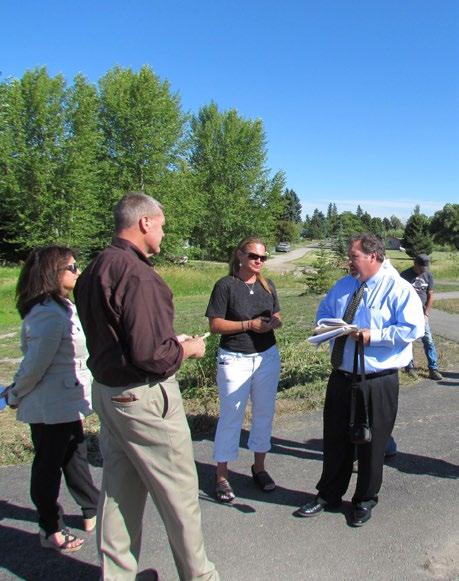
Marketing is a critical piece of the planning process to ensure current and potential stakeholders are aware of the project and its process. Press releases and other promotional activities that recognize donors and supporters of the project can help raise awareness, express appreciation, and generate additional interest.
Depending on the project, potential support can be recruited through local neighborhood groups, schools, childcare centers, parent groups, meeting halls, local gyms, recreation centers, hospitals, and therapeutic settings. Distribute flyers and brochures to elicit support, use social media (websites, Facebook®, Instagram®) to promote fundraising initiatives, key milestones, and event schedules. Create an online photo album to share emotional pictures of the space, recognize volunteers, and, after the grand opening, show how the space is being utilized.
Once you have determined the budget, goals of the project, and the overall scope, it is important to take into account some key considerations to support the purchasing process of your surfacing. There are a variety of ways to evaluate potential vendors and establish selection criteria that will help ensure you purchase a high-quality project with a trusted and reliable partner. Some criteria may be a requirement for your municipality. Potential questions and considerations include:
• Will a Request for Proposal (RFP) be required to gather relevant information?
• What specifications are required for your project, and who will write the specification to use in this and future purchases?
• Is a bid package required in your municipality?
• Are there any cooperative purchasing contracts you can utilize for your project?
• Is licensing required by the state for your project?
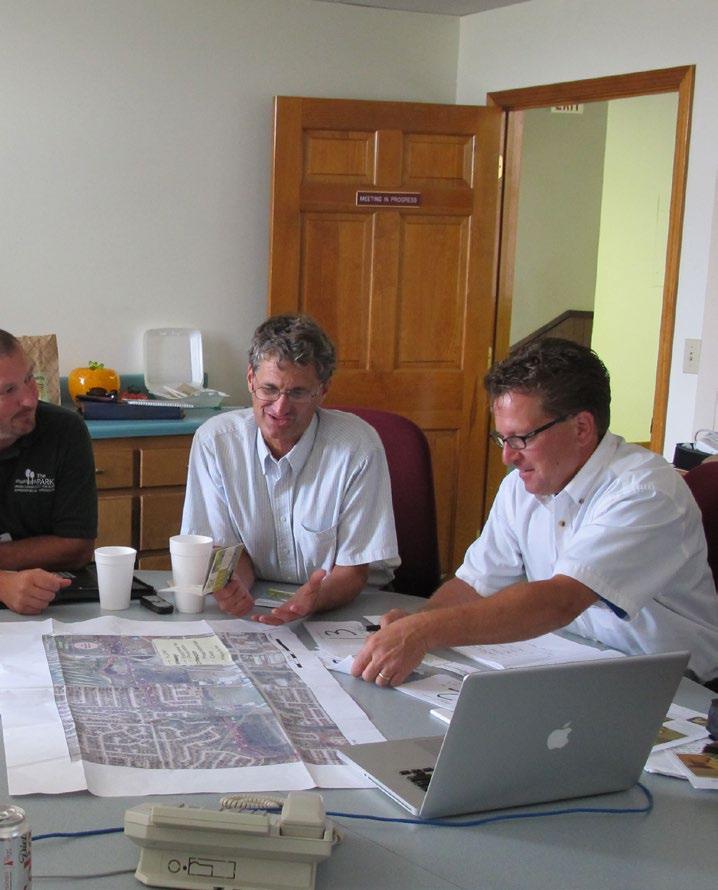
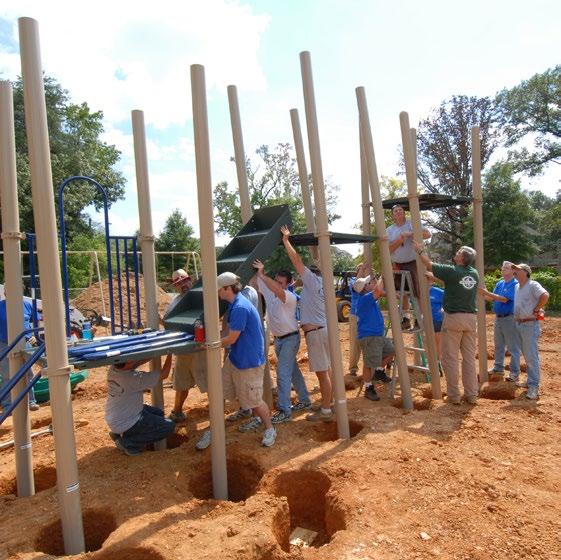

A Request for Proposal (RFP) is a document that an organization, often a government agency or large enterprise, posts to elicit a response from potential vendors for a desired product/process. It may be the preferred way for some organizations to promote their project to manufacturers and suppliers. The RFP process is a tightly structured one designed to level the playing field for manufacturers that want to work on that project, and sometimes to avoid going through the bid process. The RFP provides detail to a manufacturer on what the project entails, what the organization is looking for, and could include cost parameters. The RFP will provide a list of questions that each of the manufacturers interested in designing the project will need to answer. These questions could include prior experiences, sample timelines, company processes, warranty information, liability coverage, and other pertinent information specific to the project.
A specification is a document that defines a set of requirements that a product, assembly, or installation must meet or exceed. A product, assembly, or installation that does not meet all of the expressed requirements does not meet the specification, and often is referred to as being out of specification or “out of spec.” Specifications are used when a contract for technical products or services is issued. The technical specification defines the requirements to fulfill the contract. Creating a specification for your project is a good way to ensure any vendor bidding the job is specifying the same product/ service, and meeting all the parameters you have specified. A specification will detail items like the type of surfacing you wish to purchase, what the performance requirements will be, the ASTM standards that the surface must meet, minimum acceptable warranty, testing requirements that should be documented, and installation requirements.
You can ask a manufacturer to help you write a specification, or there may be someone on your staff responsible for writing specifications, especially if you work for a municipality or city government. A specification may be used alone, or as part of a bid specification package.
Bid packages are sometimes a requirement of some municipalities and government entities. A bid package is a very thorough and detailed set of instructions that are published publicly to let potential bidders know you have a project, and what the requirements are for them to be considered as a vendor. Bid packages are normally created by the departments of planning/engineering/architecture or a local architect or landscape architect firm. These documents provide the customer with protection while soliciting only bidders that meet the customer’s expectations. Bid documents provide a process to manage the public purchasing procedure carefully.
Customers may utilize this document to cover the exact (but not limited to) product, site, legal, wage, safety, and payment requirements. Think of this document as a guideline of what must happen to successfully complete the project per your expectations.
Cooperative purchasing networks can be helpful resources for excellent services at competitive prices without having to send the project out to bid. This can reduce bid and solicitation costs and save time. It also will allow customers to expand purchasing choice past state lines; the solicitation process has already been done and all documentation is public.
These networks will work on your behalf to secure volumepricing contracts that meet or exceed expectations. Specifically, for surfacing projects, cooperative purchasing contracts such as National IPA, BuyBoard, U.S. Communities, state cooperative purchasing, and General Services Administration (GSA) are some examples that serve most public agencies, schools and universities, publicly funded private institutions, non-profit agencies, and public hospitals and clinics.
As part of their service, the cooperative purchasing network may issue Invitation for Bids (IFB). Utilizing a cooperative network will help manage the budget with pre-negotiated pricing and will eliminate a time-consuming bid process involving potentially inexperienced vendors. Therefore, knowledgeable and trusted manufacturers and service providers will be involved in completing the project. For more information about purchasing cooperatives or national contracts refer to the National Cooperatives Purchasing Alliance (NCPA) and the National Intergovernmental Purchasing Alliance (National IPA).
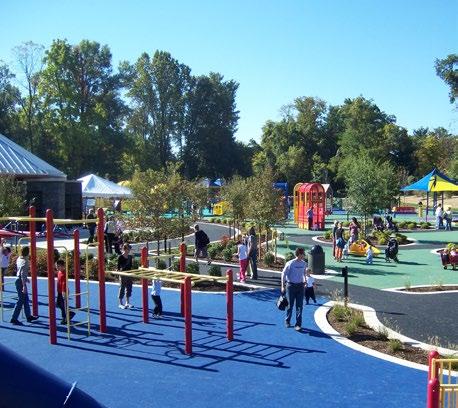
Finally, it is important to understand whether licensing is required by the state for your project. Some states will require commercial contracting licenses for some work to be performed. It’s important to check with your state government to understand what type of licensing may be required, so you can include this information in your purchasing process. Understanding these requirements will assist in budget planning and help ensure your bid package and RFPs are accurate.
Protecting the surface begins with ensuring that all of the correct steps are taken during installation in regard to drainage, slope, thickness, and installation procedure. To make sure the new surface will last, proper installation and maintenance are necessary.
Maintenance and repairs may vary depending on the type of surfacing, its usage, the environment, and other circumstances. In some cases, repairs may be needed to extend the life and performance of the surface. The following installation, maintenance, and repair considerations are general guidelines for protecting your surface.
For more information, work closely with your supplier to maximize the useful life of your surfacing.

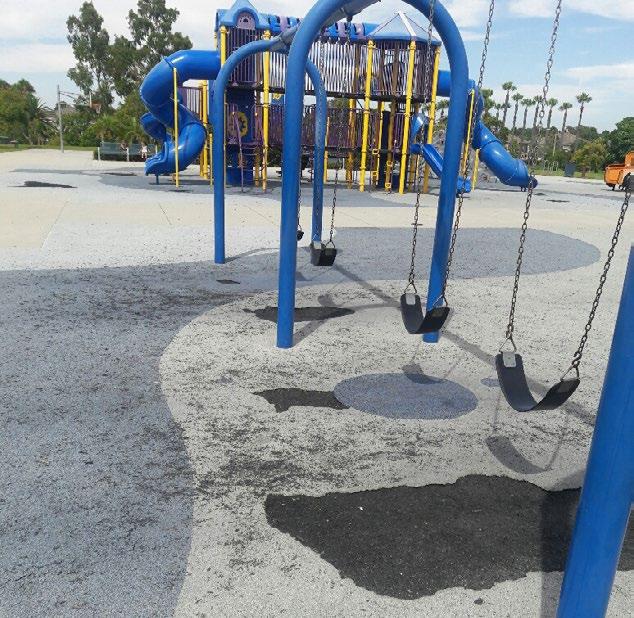
Proper installation is key to a successful and compliant play or recreational surface. All surfaces and applicable sub-surfaces must be installed exactly to specification over a well-drained, properly prepared base, and cover the intended use zone to the specified depth. It is critical that these specifications are followed to in order to achieve the same performance values the surface possessed when it was certified to ASTM F1292 and ASTM F1951


For loose-fill surfaces (EWF and shredded rubber), the use of a geotextile fabric, laid on the ground before the surfacing material is installed, may help decrease maintenance by acting as a weed barrier. Containment curbs must also be used with loose-fill materials to prevent them from migrating outside the intended use zone and to ensure that the proper depth is maintained. Loose-fill surfaces are fairly easy to install by anyone with minimal experience on surfacing installation; be sure to follow the recommended manufacturer’s instructions for depth and that the surface is properly raked and compacted to ensure it meets the specification for your equipment’s fall height and
For unitary surfaces (bonded rubber, PIP, tile, and synthetic grass), installation will require a skilled technical crew that is trained in the proper installation of the material. Refer to the specification provided by the manufacturer for details, review ASTM standards, and request a post installation inspection to ensure the surface has been installed to manufacturer’s instructions to meet specifications. Be sure to inquire about the training and qualification of the installation crew before making a purchase, as a skilled labor force is critical for the material to live up to its stated performance standard.
One example of this skill is understanding how to interpret weather conditions as poured unitary surfaces will require a specified temperature range for the installation to be successful. When installing PIP, the urethane (glue) used to bond the granules of material together is both temperature and moisture sensitive. It is not recommended to install this product when temperatures fall below 45 degrees Fahrenheit, as the urethane does not cure at the proper rate, and the molecules do not join properly because they are too cold to move. This causes the bond to be weaker than it is designed to be and could result in an underperforming final product. Heat is not as detrimental to the structural integrity of the system, it just causes the urethane to cure a little faster. Always check with the manufacturer about maintaining your warranty on the surfacing material. In most cases manufacturer’s recommend that a roll or spray coat should be applied once every 12 to 24 months depending on use, to comply and keep the warranty in force. The coating consists of a layer of specially formulated material that seeps into the pores of the surfacing and helps re-
strengthen the bond of the granules. It helps prevent cracking due to the UV rays of the sun drying out and deteriorating the material. It also revitalizes the color of the granules making the surface look new again.
Once installed, be sure the surface is properly cured before allowing users to utilize the space. The cure time of the surfacing material is dependent on the temperature and humidity of the area. It is advisable to wait a minimum of 48 hours after the surfacing is installed before the new surface is used. Most unitary surfaces are soft and wet like paint or cement when first installed and will show footprints or marks if disturbed before curing is complete. In addition, using a six foot temporary construction fence to protect the project is highly recommended. Fencing would be supplied by the customer or the general contractor (GC) unless specifically requested.
Upon completion of a project, obtain a letter of compliance and project specific warranty. Keep these documents in a file, along with other documents pertaining to the job and all future inspection records. Good maintenance is the key to protecting your investment. Your manufacturer or installer should provide you with a maintenance guidebook pertaining to your specific surface. Every site owner or recreational surfacing manager is responsible for planning and executing a scheduled inspection plan. Supervision is also important to ensure the playground or recreational space is being used properly.
Before your surface is installed, it’s a good practice to discuss drainage with a local engineer or engineering consultant as its performance may be dependent on location and the characteristics of the site. An engineering consultant may issue a drainage plan to be executed prior to surfacing installation. The drainage of the site will be part of the general excavation before the equipment is brought in and is a critical factor for a good installation. You don’t want to invest in a brand-new surface, then find out after installation that the drainage of the site is detrimental to its performance, or the ability of people to enjoy the site.
Ensuring proper slope and grade are important steps for correct installation and performance of surfacing. For details on slope requirements or recommendations, consult the 2010 ADA Standards and ASTM F1951 Standard Specification for Determination of Accessibility of Surface Systems Under and Around Playground Equipment. The rule of thumb is generally 6% running slope and 2% cross-slope for all surfacing areas. For the sub-base, 3% is acceptable. Suggested sub bases include 95% compacted stone, concrete, and asphalt.

For surfaces being installed at a playground, there are specific guidelines in ASTM F1292 that determine how much surfacing needs to be present to meet the applicable standards, both for overall area, and material depth. These are based on the fall height (the distance between the designated play surface and the ground) as well as the use zone, which is the area around a piece of equipment where play experiences with that equipment are expected to take place. Your playground or surfacing vendor should be able to provide this information as part of their proposal, but it’s a good idea to be familiar with the parameters.
Depending on the material and manufacturer, these are variable guidelines regarding depth of the chosen surfacing:
PIP rubber installation depth will vary by manufacturer but it is estimated at about 1½” to 5” thick, depending on equipment fall height.
• EWF will need to be between 9” to 12” deep depending on fall height requirements.
• Shredded rubber (loose fill) will need approximately 6” of depth.
• Sand will need to be 12” deep (4’ max fall height per CPSC) but it is not suggested to use this surface for high fall surfaces, or for accessibility, as it will not meet the ASTM guidelines for access.
• Rubber tile is variable in thickness. Tile thickness will be dependent on equipment fall height and dependent on manufacturer.
Synthetic grass will vary by manufacturer but it is estimated at about 1½” to 5” thick, depending on fall height requirements.
All surfaces must be maintained to remain compliant and to help extend the functional life of the product. Even under the warranty period, there are care guidelines for each type of surfacing that should be carefully managed.
Check to see if the surfacing is loosely packed and covering all appropriate areas, especially fall zones surrounding the equipment to ensure the surface is compliant with standards. Ensure that the surface is level, at the proper depth to attenuate falls from the equipment, and that all containment curbs are firmly in place. Visually inspect areas under slides, swings, and other concentrated areas that may need a top-off of materials in order to retain the proper critical fall depths and maintain accessibility.

During routine inspections, regular raking of material is required under slides, swings, certain fitness equipment, and other concentrated use zones, landing zones, or where foot dragging is common. Raking alone may not ensure the area is compliant, so top-off materials may be necessary in order to maintain the proper depths for fall attenuation and accessibility. Placement of wear mats in heavy use areas can help reduce displacement.
If the surface material retains moisture, it will freeze at temperatures below 32°F (0°C). The surface should be checked when the temperature falls below freezing, as this may affect fall attenuation properties.
To maintain the surface at the recommended depth, comply with warranties, and help ensure accessibility, you will need to top-off the area as necessary. When the surface compacts, decomposes, or is displaced enough to reduce the original depth, contact your supplier to order additional material. Failure to maintain surfacing at the initial installation depth may result in an injury and/or void your manufacturer’s warranty.
Rake the play or recreational area level. During routine inspection, remove any foreign objects such as glass, rocks, and litter and discard these materials.
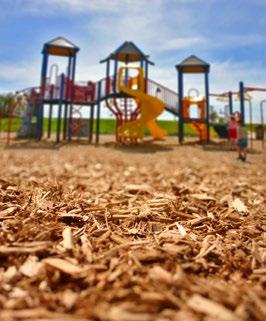
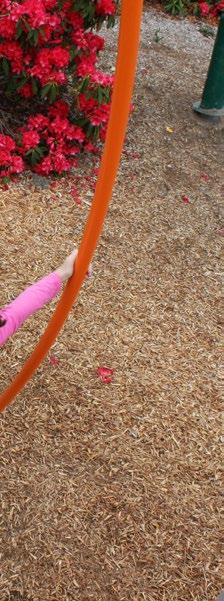
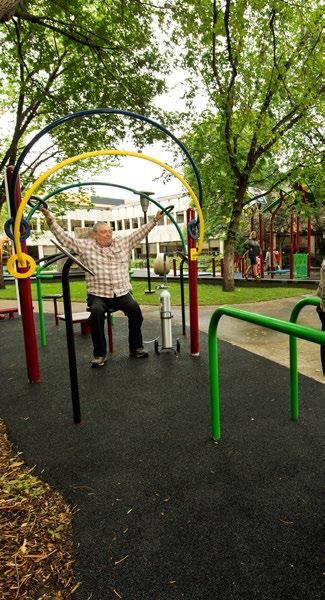
Inspect the surfacing to ensure no cracks, punctures, or other damage has occurred that will require repair. Look for general wearand-tear, paying close attention to high impact areas. Damaged areas should be patched by a certified installation crew to the same standards of the original installation. Look for flaking of the wear layer, which may indicate service is needed to ensure proper product performance. Look for foreign materials, which can be blown off or picked up, and inspect the surface for stains that may need to be cleaned.
Heavy use areas may wear faster and require roll or spray coating to prevent flaking. Inspect heavy use areas like under swings, spinning devices and at the base of slides, and contact your supplier if you have questions about the surfacing’s condition. For stains and dirt in heavy use areas, refer to cleaning recommendations that are specific to the product.
Use a blower or vacuum to remove loose debris. For outdoor applications, hose off the entire playground or recreational surface to remove dirt and debris as needed.
Poured-in-place surfacing requires regular roll or spray coating to help promote its vibrancy and longevity. This procedure consists of rolling a thin layer of the same urethane binder used in installation over the entire playground surface (see photo below). Roll or spray coating should be conducted every 12 to 24 months depending on use, weather conditions, and other factors. Contact your manufacturer or sales representative to help understand the recommended frequency of roll or spray coating for your project.
Regularly remove loose debris such as sand, dirt, and small stones to help reduce slip hazards. Fine particles can also accumulate in the porous openings and clog drainage. To achieve best results, use a vacuum or blower to clear the surface as well as to remove litter. Sweeping or scrubbing will remove litter but may force fine particles into the porous surfacing.
On heavily stained isolated spots, while the surface is damp from hosing, apply a sufficient amount of a mild household or commercial detergent. For adequate coverage, use a hand-held spray bottle to apply, then scrub thoroughly with a soft bristle scrub brush. Repeat as necessary on extremely tough stains. It’s best to work in 4’x4’ areas. These cleaning procedures provide no guarantee of stain removal. However, a stain may become more difficult or even impossible to remove if not addressed immediately. For difficult stains, refer to the specific maintenance guide provided by the manufacturer. Do not use any steaming or hot water machines for cleaning as this may cause delamination of the surface.
General Inspection
Hose off entire play or recreational surface to remove dirt, loose debris, or any other foreign elements. This can be part of a monthly routine maintenance program. A pressure washer may be used provided the water pressure does not exceed 1,500 psi and the spray nozzle should not be closer than 12 inches to the surface. This type of maintenance should be done only on an as-needed basis. On heavily stained isolated spots, while surface is damp from hosing, apply a sufficient amount of a mild household or commercial detergent. For adequate coverage, use a hand-held spray bottle, scrub thoroughly with a 10-inch medium basin bristle scrub brush and repeat as necessary on extremely tough stains.
General Inspection
Basic precautions and care will ensure that the synthetic grass will maintain its appearance and performance for many years. Proper maintenance can do a lot to protect the investment for future use. It is suggested that maintenance professionals brush the surface monthly, using a power broom or a push broom. The operator should sweep against the fibers to stand the blades of turf. As needed, top-off infill to fill in low spots. Keep surface free of leaves, grass clippings, or other debris. A leaf blower works well to help keep the surface clean.

BEFORE AFTER
Varying surfacing materials will require different methods of repairs. Repairing a surface will extend the life of the product and help ensure it meets performance standards. While some of the more common maintenance requirements, like topping off loose-fill surfacing to compliant depths may be performed by your maintenance team, repairs to unitary surfaces will will require professional crews with the specialized knowledge and training to ensure all standards are met after repairs are finalized. Always check with your manufacturer for specific guidelines on how to repair the product.
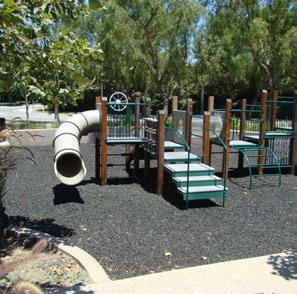
Unitary surfacing may be affected by granulation, cracks, holes, and UV rays, leading to the need for repair or refurbishment. Issues like vandalism, movement in the tiles, erosion, poor drainage, or worn areas that result from repeated impacts may also result in the need for repair. In all cases, repairs should be made immediately as per supplier’s instructions to ensure product performance.
Below is a list of common repairs for PIP and information on what to expect if a full replacement needs to be done. The chart on page 30 provides a quick overview of each of the repair options.
Always check with your manufacturer on how to do patch repairs for the type of protective surface installed. Small holes can be easily patched before they become bigger problems. The surface color and design can often be matched to what was initially installed. Repairs can usually be done in less than one day, so play and recreation can continue the following day if the product has properly cured. A facility’s maintenance
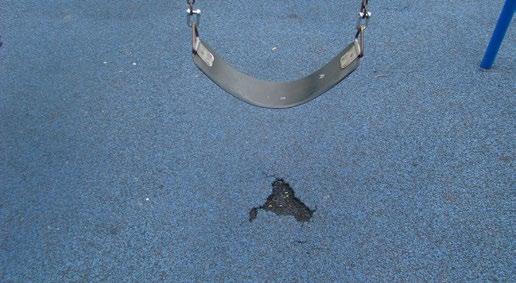

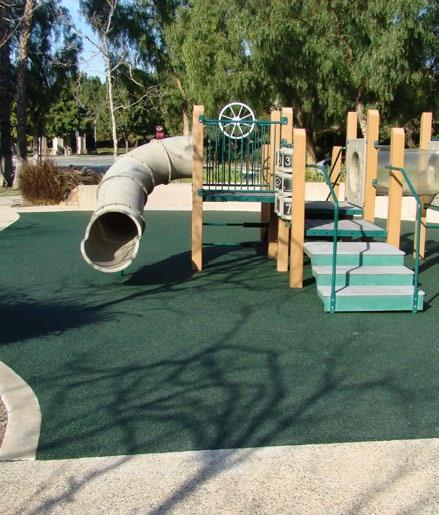
department can be trained to repair holes using the manufacturer’s instructions and the correct supplies for repairs less than 10 square feet. Contact your supplier for more information.
After prolonged use, color seams can start to separate. Repairs can be made by a trained crew to eliminate these cracks and renew the color designs that add value to the play and recreational area.
Like color seams, perimeters may start to separate due to heavy use or weather-related conditions. These separations can also be easily repaired by a professional crew.
Experts suggest routine application of a roll or spray coat to preserve against weather and heavy traffic. The urethane penetrates the top (wear) layer of the pad to strengthen the bond of granules. The coating provides UV protection from sun damage and helps prevent holes, cracks, and granulation on the protective surface. It should be applied via roll or spray coat by a professional crew every 12 to 24 months to rejuvenate the play or recreational surface.
Sometimes, a surface is beyond patch repair. When the wear layer is riddled with holes and cracks, and the underlying cushion layer still has the proper attenuation needed for your critical fall height, replacement is recommended. This application must be performed by a trained crew and consist of removal of the top wear layer and the installation of a new one along with additional attenuation where required. The new top layer should match the existing color or in brand new colors and/or designs.
Surfaces that are very old, have suffered poor maintenance, were not properly installed, or in cases where the underlying cushion layer lacks the proper attenuation properties, the surface may need to be replaced entirely. They will require both the wear layer and cushion layer to be completely removed, and a new surface will be installed in its place. A manufacturer or supplier can review the poured surfacing choices and explain the options to replace the surface fully.

Suggested for
Small holes or spider cracks, usually under swings, at slide exits, or in highly used areas with PIP materials Professionals or trained maintenance crew*
Where colors or materials meet
Expert professionals
than 1 day 1+ years $ PERIMETER REPAIR
Where surfacing meets the border
Expert professionals
than 1 day 1+ years $ PREVENTATIVE ROLL OR SPRAY COAT APPLICATION
LAYER REPLACEMENT (AKA RETOPS)
Suggested routine maintenance at least every 2 years. Can be used for small or large spaces, usually rolled or sprayed to the top of an existing poured-in-place surface
For damaged play pads with more than 2-3 holes and cracks or spaces with extensive granulation
Expert professionals 1 day 2 years $ $
Expert professionals 2 days 2+ years $ $ $ FULL REPLACEMENT
For spaces worn beyond the wear layer that require a complete removal to meet compliance regulations
Bonded rubber can be patched or replaced in areas of wear or damage. Roll or spray coatings can help extend the life of the bonded rubber product. Ask your supplier if a kit is available so that your maintenance crew can make these repairs. Repairs generally consist of symmetrically cutting out the affected area utilizing a beveled cut to strengthen the seam. The area and connecting edges are primed to bond the new patch to the old surfacing. The bonded rubber is then mixed with urethane according to the guidelines, and troweled in, matching the height of the existing surface and emulating the degree of compaction. The area should be secured for 24 hours to cure before allowing use.
Repairing rubber tile surfacing projects is easier than most unitary surfaces as the damaged tile can typically be cut out and removed, and new replacement tiles can be glued back in place. Your supplier should be able to provide you with instructions. Allow 24 hours before reopening the environment to allow for proper drying time. Lastly, as with PIP and bonded rubber, some tiles, depending on the material, can also be roll or spray coated to help extend the life of the product.
Expert professionals 2+ days depending on size of space 5+ years depending on routine maintenance $ $ $ $
Synthetic grass can also be patched, but requires a skill set similar to a carpet layer, as the material must be patched and seamed to ensure adherence to the surrounding material. Ask your supplier for the best way to handle a repair to synthetic grass surfacing. The repair should have a minimum of 24 hours to cure before using. Areas that have lost infill among the fibers can easily be replaced with a synthetic turf rake, broom, or hand brush.
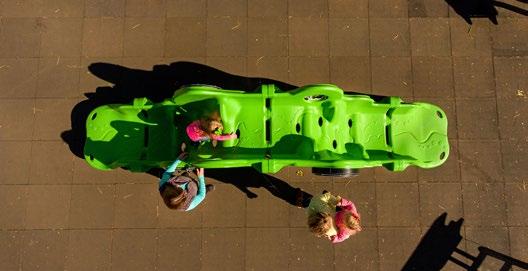


Discover how a variety of communities utilized surfacing products, color, texture, design, and other criteria, to create fun, well-loved play and recreation spaces that meet the diverse needs of users. Mt. Greenwood Park, illustrated in this introduction, utilized poured-in-place surfacing to highlight art components, play areas, and sculptural instruments that were inspired through community workshops. Users enjoy the colorful, tactile experiences highlighted throughout the space.
To share your surfacing success story, log on to www.playcore.com/strongfoundations.

Use of whimsical designs creates a dramatic visual effect while various natural colors help to organize the play environment and complement the natural theme.
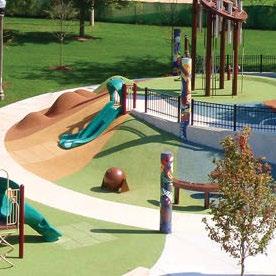

Poured-in-place surfacing is used on existing topography to create a hillside slide, while small play mounds create unique features designed into the surfacing.
Reinforced wear layer underneath the slide exits help protect the surfacing under highly utilized exit zones.

Splash pad surfacing provides a safe surface for users to enjoy water play and cool off in warmer weather.


Kade’s Playground is designed so that children with and without disabilities can play together side by side. All
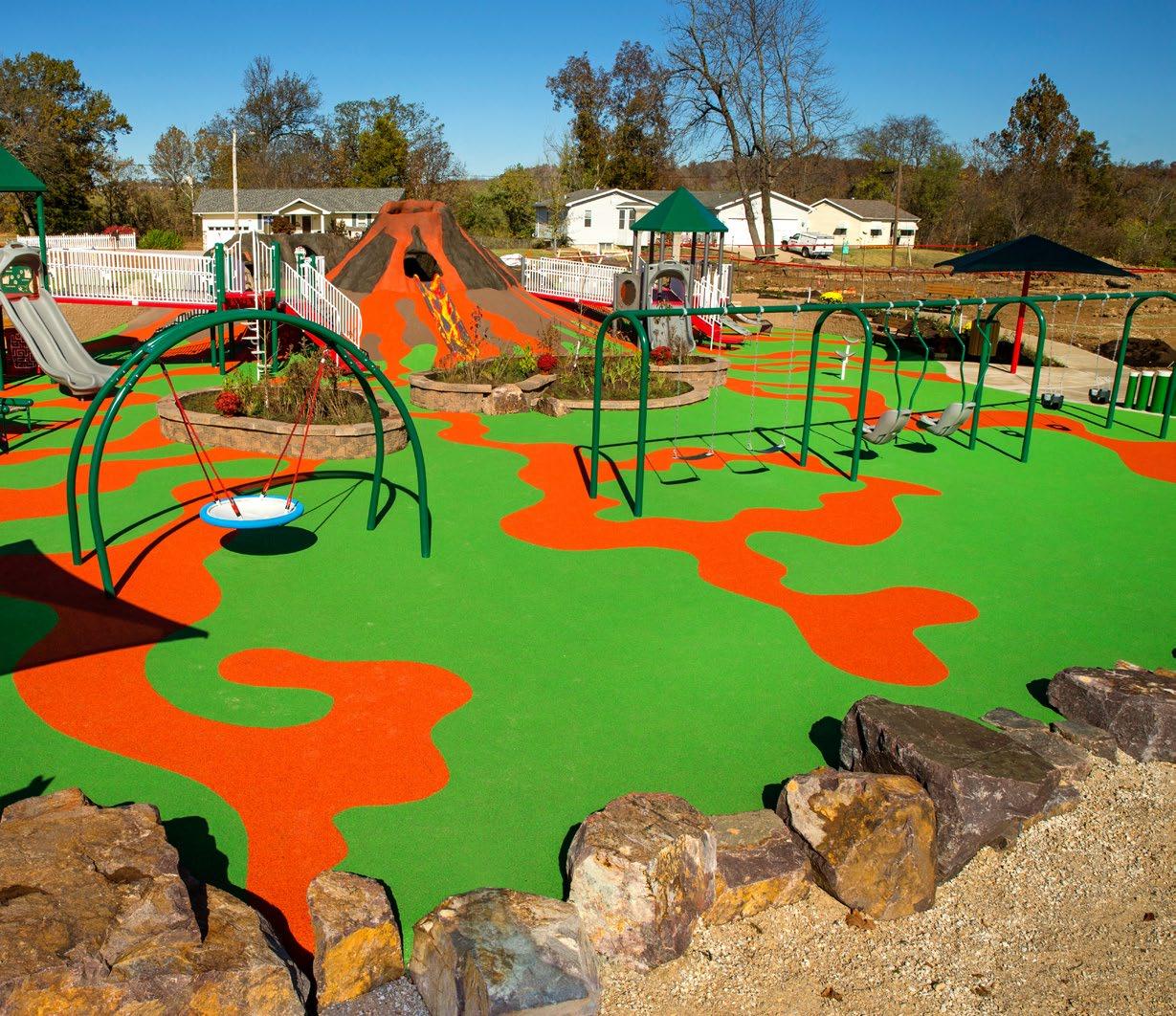
Colored lava makes a dramatic impression by extending the volcano theme from the equipment to the surfacing.
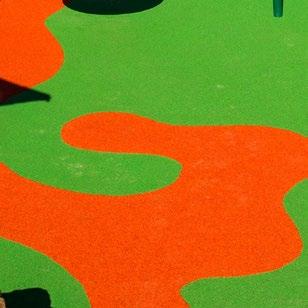
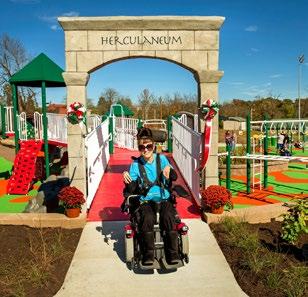
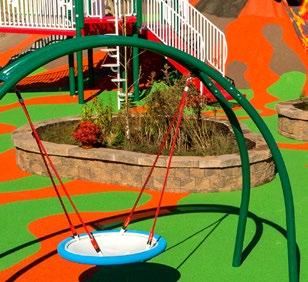
Clever design using green, brown, and red colors create areas of “dirt, grass, and lava,” expanding opportunities for imaginative play and games to the surface.
Natural topography is utilized with curbing and an accessible ramp to elevate access and create a vista to the overall surfacing patterns.

Surfacing material is utilized to extend halfway up the “volcano” creating a cushioned texture to enhance play and comfort.
Planting pockets incorporated around the perimeter and into the overall play surface extend nature and offer opportunities for loose parts play.


The destination park incorporates a variety of elements to ensure that children of all abilities can play together. The use of unitary and loose-fill surfacing provides accessible routes throughout the play environment and creative use of color, textures, and loose part play offer additional play value and organization for the users.

Both unitary and loose-fill surfacing are strategically used around adaptive swing seats to provide the best option for accessibility in a cost-effective way.


Poured-in-place is utilized around playground equipment to provide a lower maintenance safety surface for children developing skills such as climbing.
Using a variety of surfacing options including synthetic grass, poured-in-place, and engineered wood fiber provides multisensory features such as color and texture, while providing visual organization and cues within the play environment.
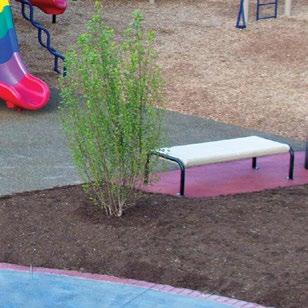
Naturalized pathways, boundaries and planting pockets provide sensory appeal and encourage physical activity. Children enjoy and benefit from loose part play interacting with engineered wood fiber, sand, and child-friendly plants.
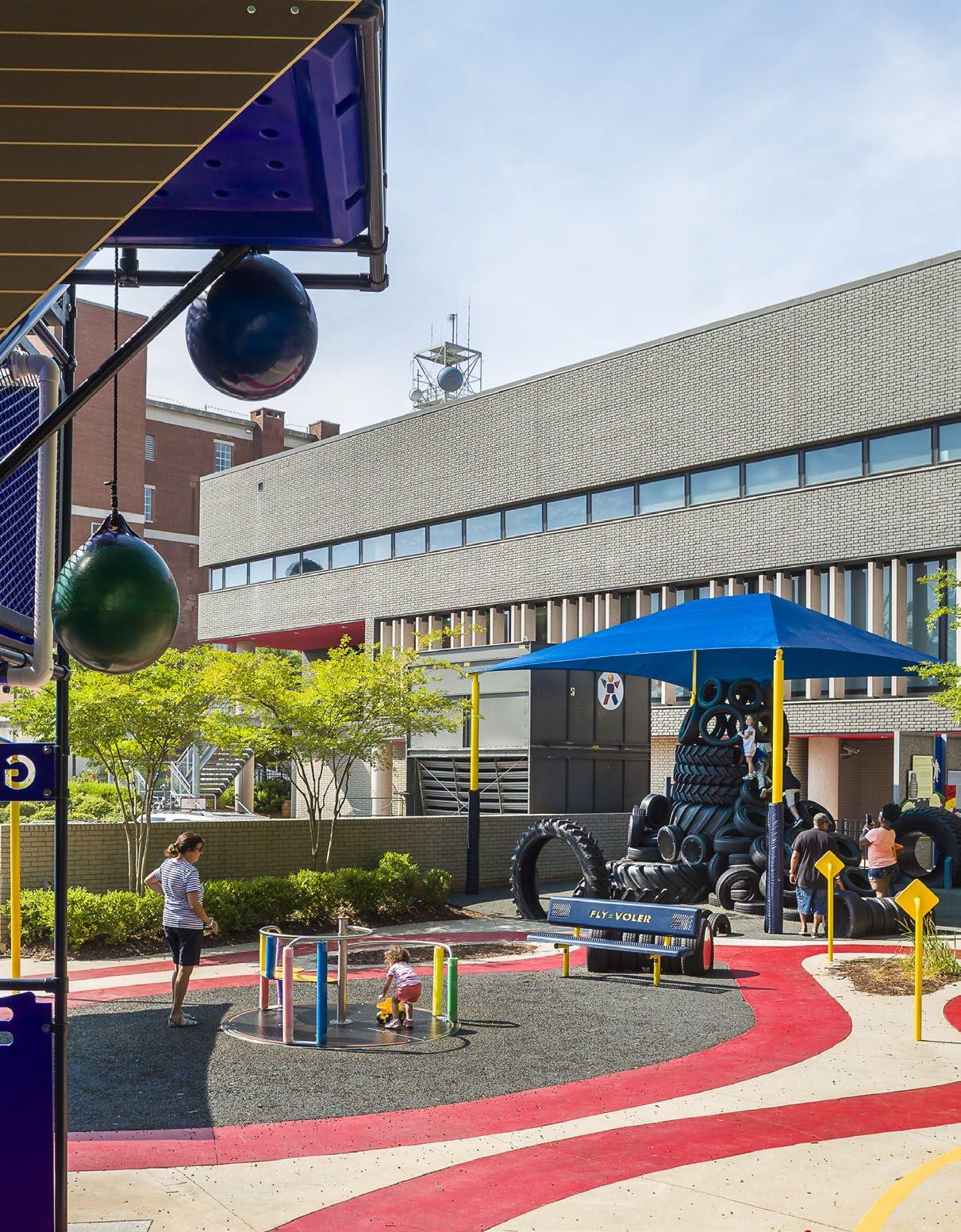

The Children’s Museum of the Upstate opened in 2009. Conveniently offering reciprocal memberships in two locations, TCMU’s downtown Greenville, South Carolina, location allows visitors to experience 80,000 square feet and 19 exhibit galleries, suitable for children ages 1-15, with components and programming in the areas of arts, humanities, sciences, health, nutrition, and the environment. The outdoor play area promotes physical activity and fun with gathering spaces, planting pockets, and a creative climbing zone. The surfacing is designed to complement the space and provide routes of travel to promote exploration of this fun, outdoor environment.

Pathways help create a sense of place while encouraging movement and exploration.
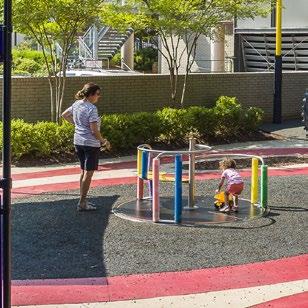
Unitary surfacing in sunny and shaded play areas give users more choices and sensory rich experiences.

Poured rubber complements the rubber tires used in the space.

Alternating loose-fill and unitary surfaces with planting pockets and landscaping increase the play value and the aesthetic appeal of the environment.
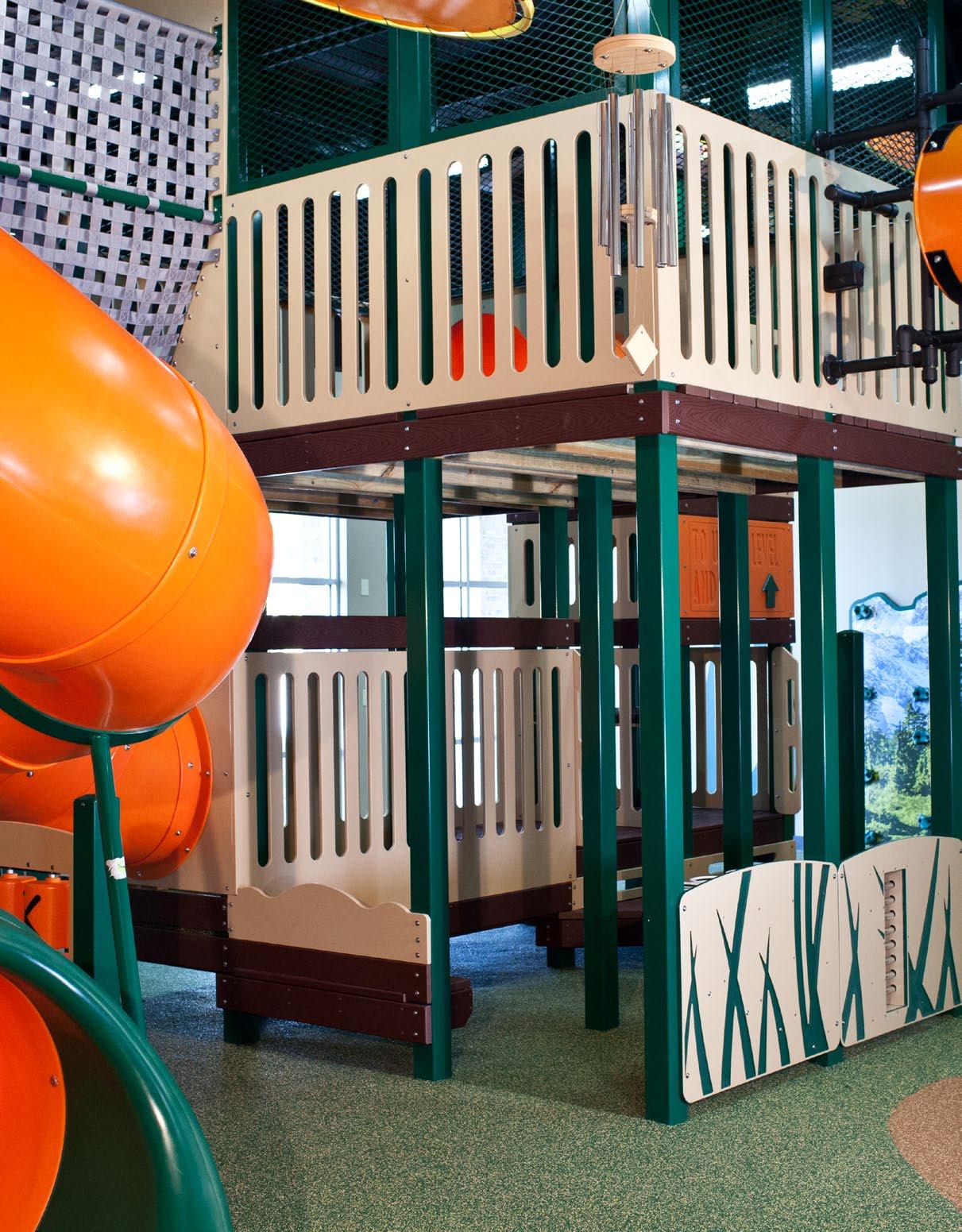

To complement the indoor play environment and create an interesting design, poured-in-place rubber in green and tan was used. The custom indoor play unit for children 5-12 years of age offers a hunt club theme area while the infant exploratorium for children aged 6-23 months features ground-level interactive panels. Wall accents such as grass cutouts, a wall-mounted rock climbing panel, and two large flowers are included to provide an outdoor feel indoors.

Poured-in-place rubber design and color schemes that harmonize with the play equipment were chosen.


Surfacing colors are used to provide visual cues to separate the various play areas.
Indoor theming creates an immersive outdoor sensation by aligning walls, ceilings, floors, and play activities throughout the environment.
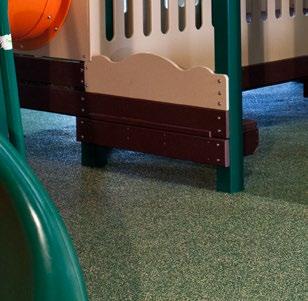
The “spongy” texture of poured-in-place surfacing adds a fun element of discovery for ground level players.



Warner Park is centrally located in Chattanooga and offers residents a variety of ways to be active, including a recreation center, outdoor fitness stations, a zoo, splash pad, baseball diamonds (including an inclusive Miracle League field), sport courts, and a playground. Warner Park managers chose fun baseball themed graphics to include with their playground to align with the rich heritage of baseball at the park.
Playground use zones are distinctly identified by using contrasting (brown) poured-in-place surface colors.


Poured-in-place rubber baseballs expand the theming of the nearby baseball diamonds to the playground, and create opportunities for game play.
Poured rubber surfacing is used for an adjoining sport court and baseball diamond, increasing inclusive play opportunities for people of all ages and abilities.
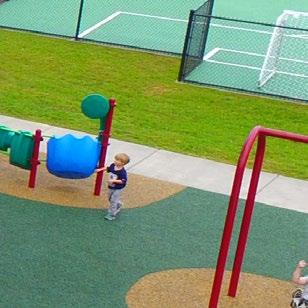
Concrete primary and secondary pathways provide access and encourage users to explore the many features of the park.
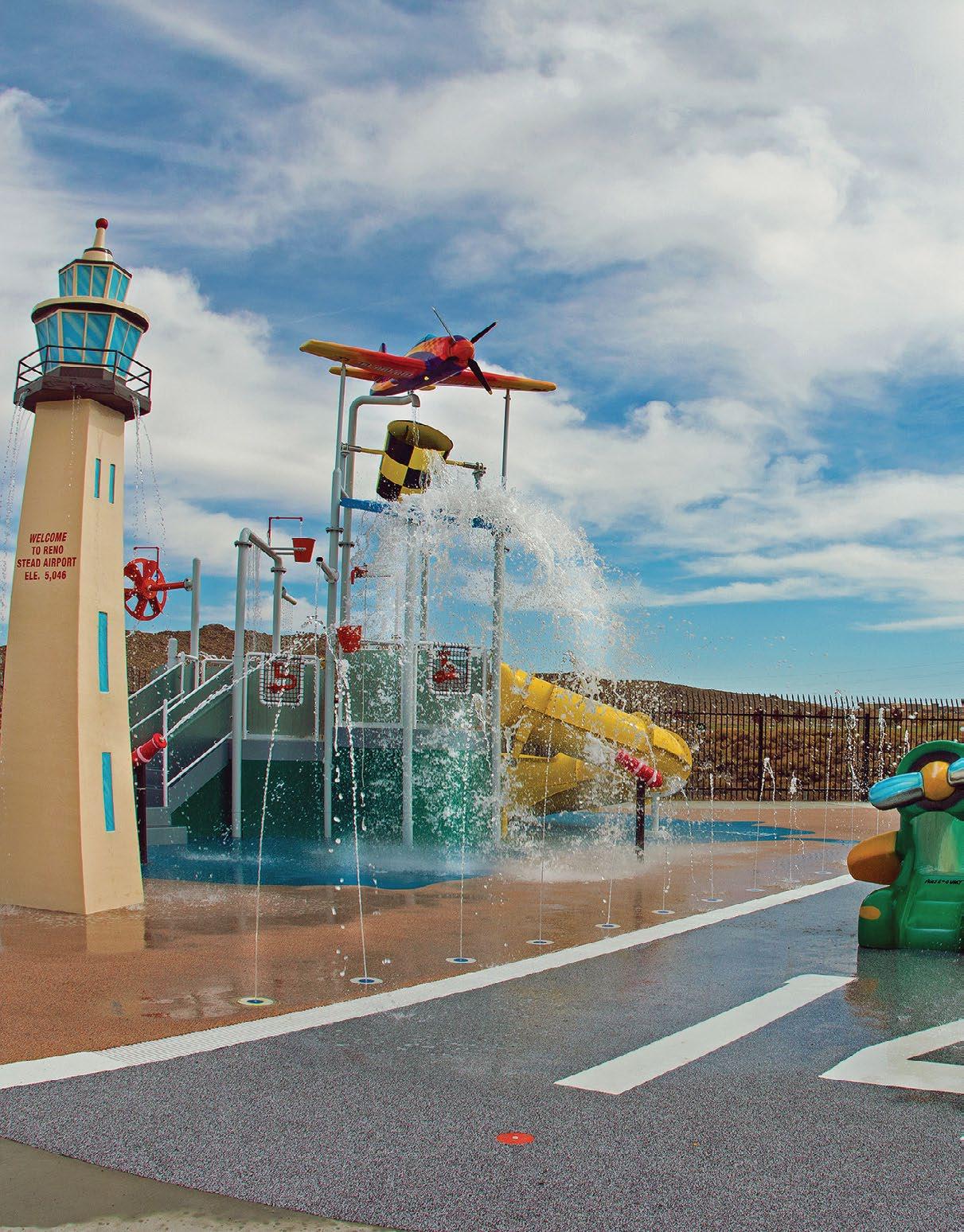


The surface is prepared to avoid standing water, and slip resistant surfacing was selected to promote safety in the play area.
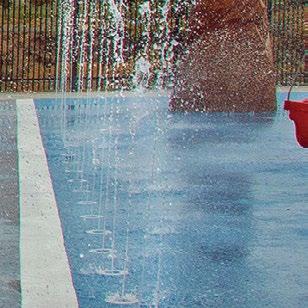
Comfortable surfaces promote diverse play behaviors.
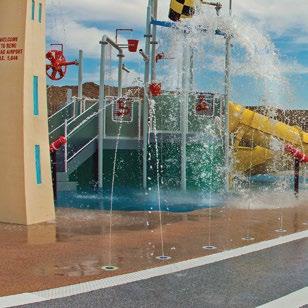
Using a variety of colors in whimsical shapes and recognizable themes provides aesthetic appeal and an invitation to creative play.
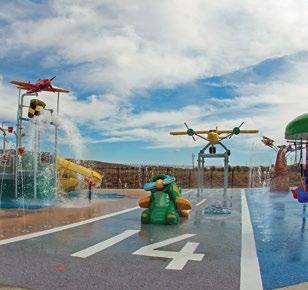
Various surface colors organize the play area between ground level play components and active play.
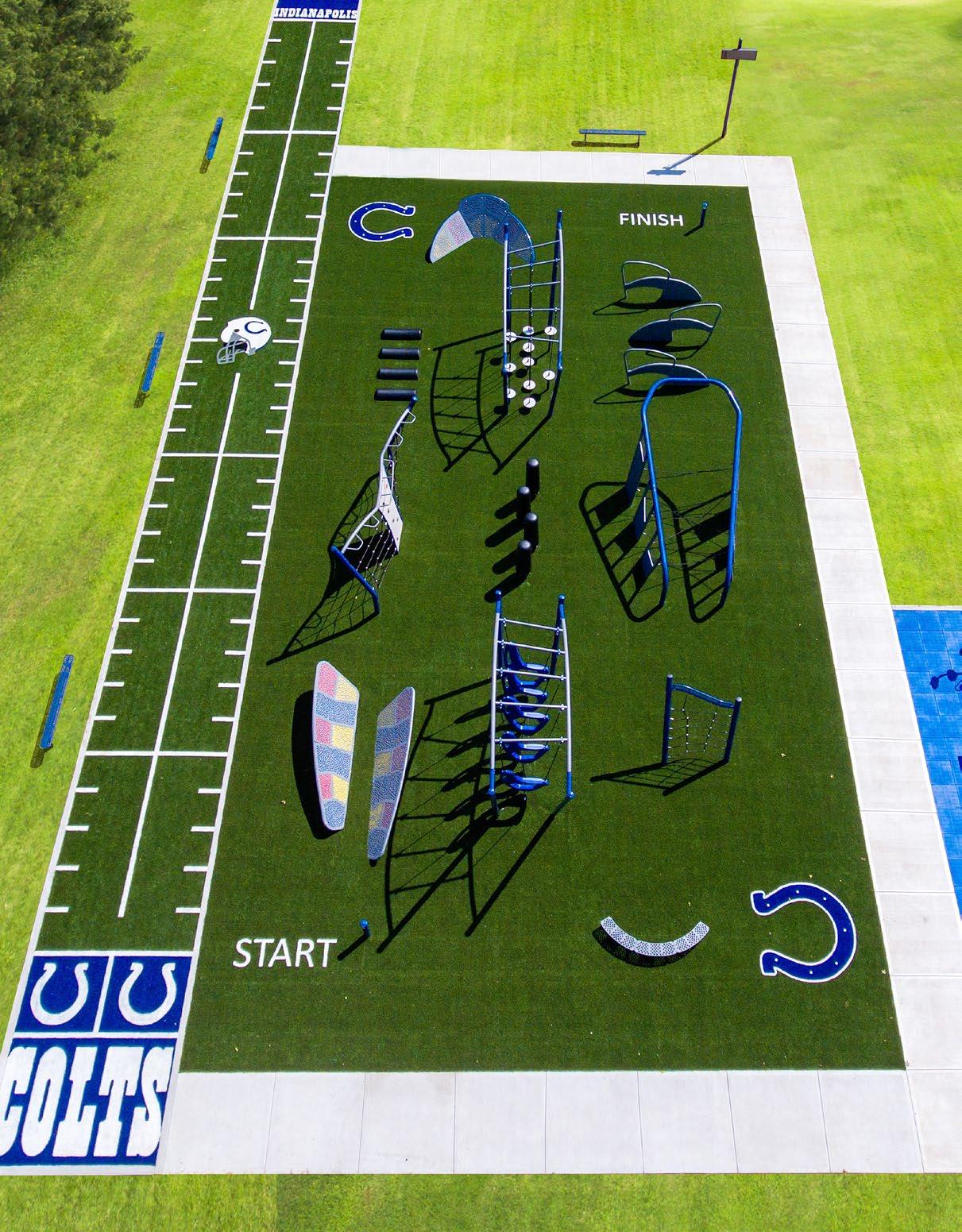

Colts Fitness Park is located in Riverside Park and opened to the public in September 2016. The park includes a PLAY 60® Challenge Course, 40-yard dash, and exercise equipment. With over 5,000 square feet of space, the park lends itself to the whole family. While adults can get a workout in on the exercise equipment, both children and families can run the challenge course and 40-yard dash together. Riverside Park serves a large and vibrant community, and Colts Fitness Park will serve 30,000 individuals annually.
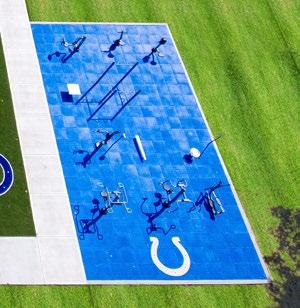
Contrasting surfacing (tiles) used for the adult fitness space provide visual cues and separation from the family-centered challenge course.

Graphics utilized in the turf provide visual cues for starting, finishing, and maneuvering the course.
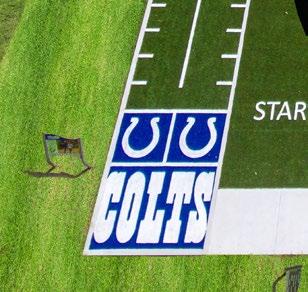
Custom logos in the turf and tile provide unique branding and sponsorship opportunities.

Primary and secondary routes of travel provide connectivity within the park.
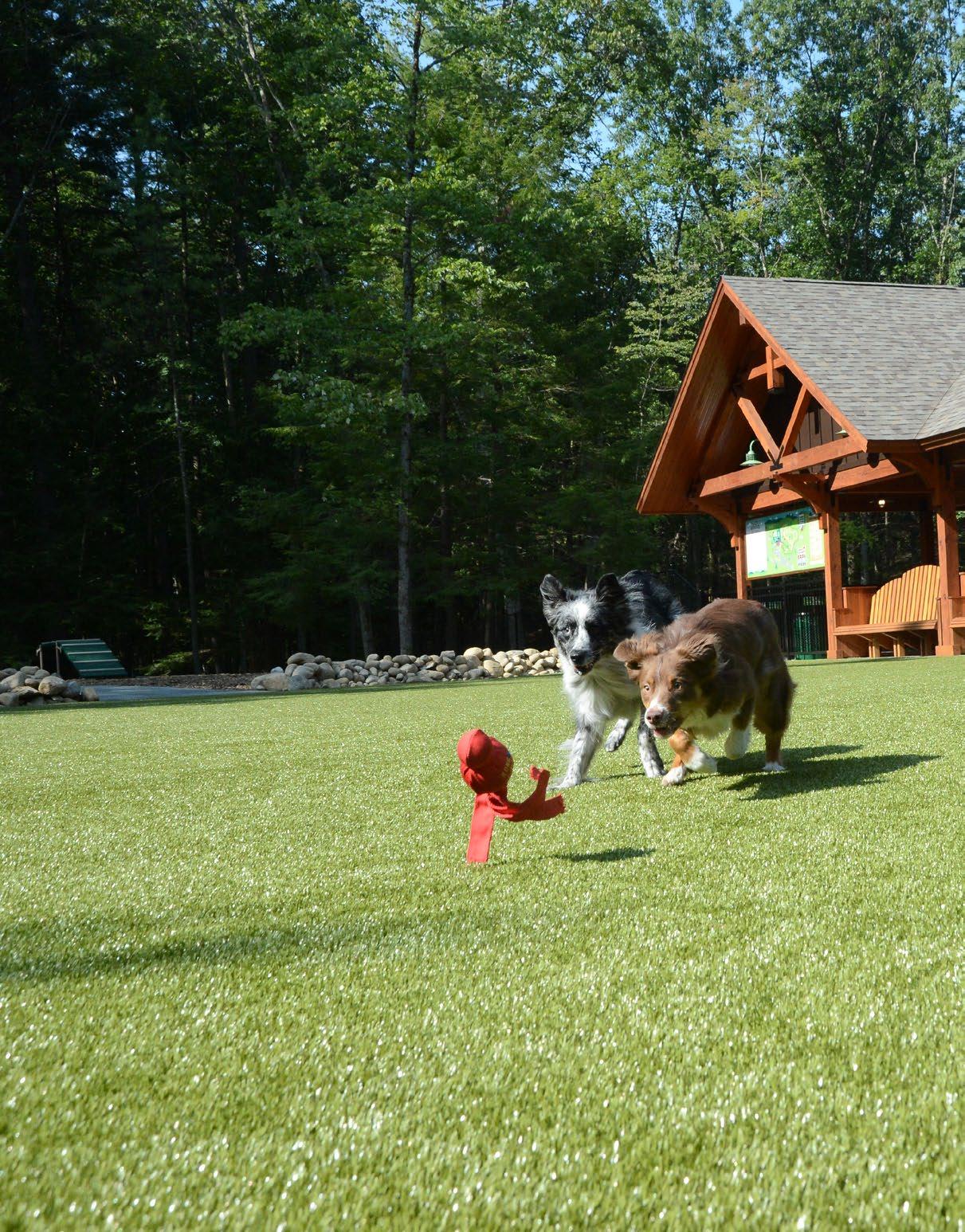

The 2 acre off-leash dog park offers walking paths, a 10,000 square feet turf play area, spray fountain, agility equipment, and other elements that are sure to get some tails wagging. In addition, a pavilion located at the entrance of the dog park, houses a dog wash station, pet treats vending machine, and accessible restrooms. A combination of different surfacing materials were used to delineate the space. Turf, grass, and engineered wood fiber provide aesthetic appeal and increase physical activity of those visiting the dog park boulders.
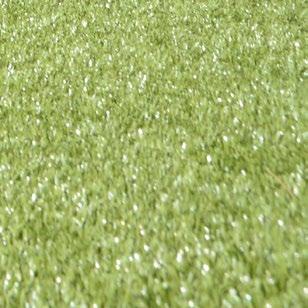
Turf provides the beauty of grass without the need to mow or fill in holes that may be dug by active dogs.
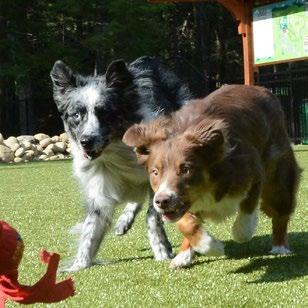

Specialized dog park turf offers antimicrobial properties along with aesthetic appeal and functionality.
Pathways and routes of travel transition seamlessly from one surface to the next, assuring comfortable navigation for people of all abilities.
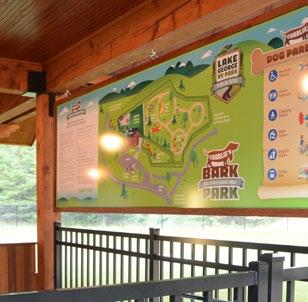
Clearly Identified routes of travel lead users to amenities such as signage, water fountains, restrooms, seating, and more.
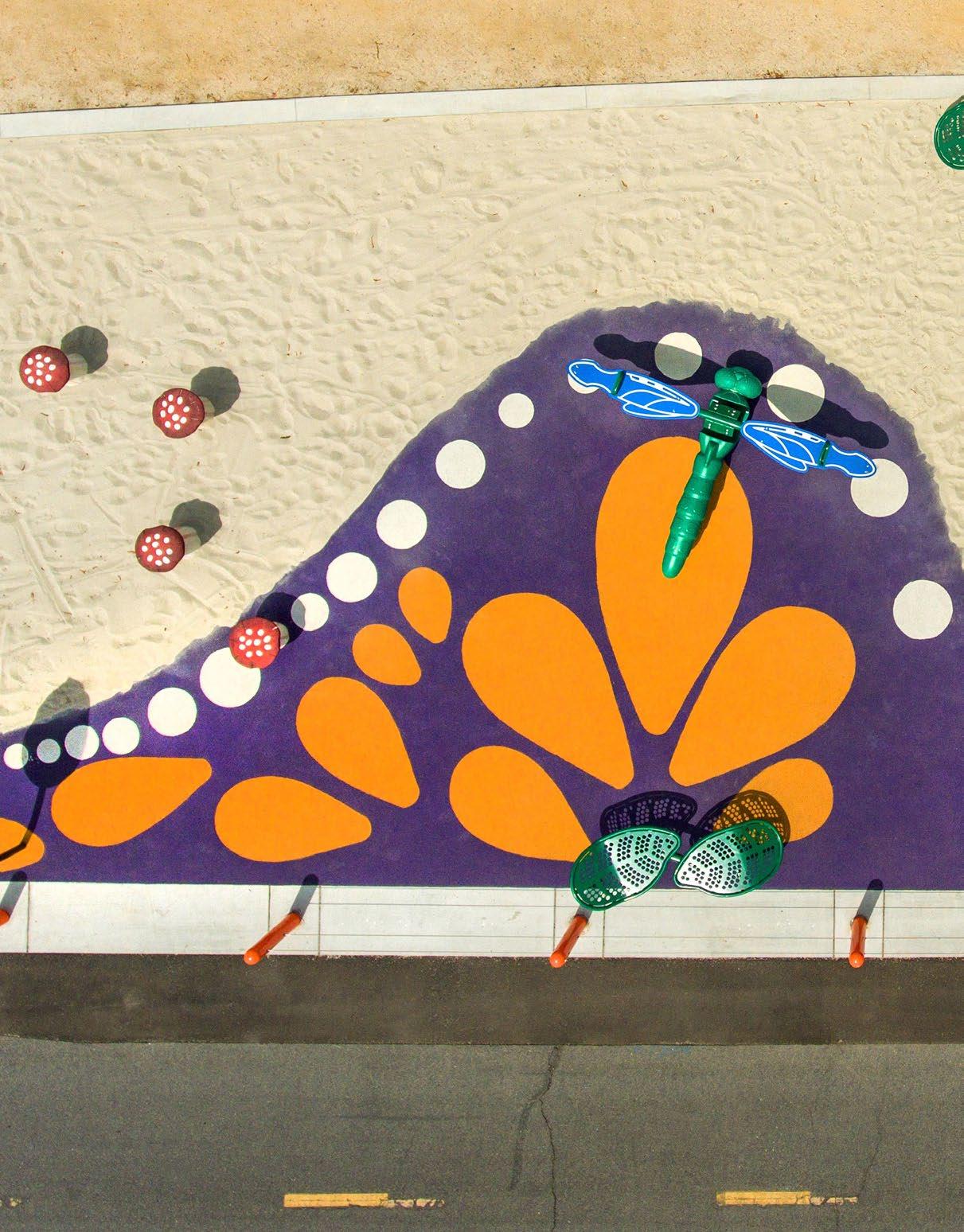

The Santa Ana River Trail is a 12-foot wide path following the Santa Ana River, a waterway that is cement-lined through much of Orange County but free flowing in Riverside and San Bernardino counties. The popular trail links inland neighborhoods, businesses and shopping districts with the beach, and provides colorful places for families to play and engage with nature-insect themes along the way.

Colorful, nature themed graphics enhance the persona of the space and delight the users.
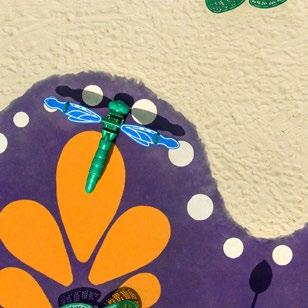
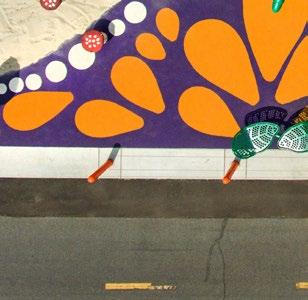
Dots, shapes, and linear graphics offer opportunities for inventive games, discovery, and exploration, while enhancing educational value of the equipment.
Seamless transitions from the biking/ walking path to the play area ensure accessibility for users of all abilities.
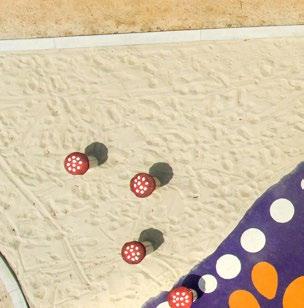
Intentional loose fill (sand) and unitary surfaces (poured-in-place) provide opportunities for sensory play and physical activity.


Ken Malloy Harbor Regional Park is a reborn, 231 acre oasis after a three-year, $111 million expansion / restoration project. Located on the border of Harbor City and Wilmington, it serves multiple neighborhoods and is a destination for outdoor fitness. The park features three adult fitness areas, separated by color to promote rehabilitation, general fitness, and advanced fitness techniques. Adjoining the adult area is a multigenerational space where children and adults can climb, traverse, and move throughout a climbing structure of nets and man made boulders. It is across the street from Kaiser Permanente Medical Center in Harbor City, which sponsors several exercise clubs and classes in the park.
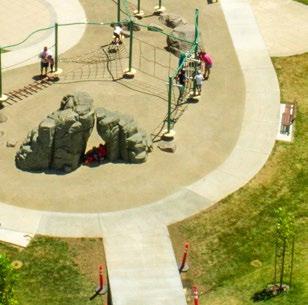
Primary and secondary routes of travel provide connectivity between areas within the park and encourage users to increase their physical activity.

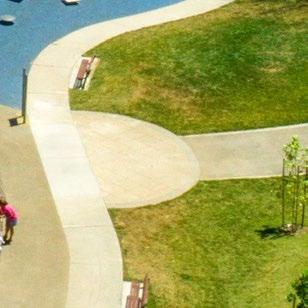
Areas intended for different exercise types are clearly identified through the use of color to create zones.
Circular inserts of poured rubber are located at the main pathway entrances to inform users they are about to enter an active area.
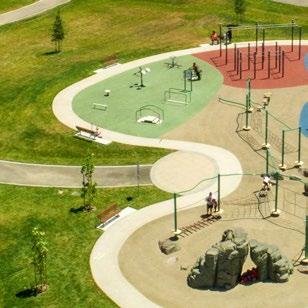
A variety of materials are used, including brushed concrete, gravel, poured rubber, and grass to create a pleasing mix of texture within the space.
• Sandboxes
• Playgrounds
• Dog parks
• Landscapes
• Trails
• Playgrounds
• Landscapes
• Trails ADVANTAGES
Low cost, easy to install, readily available
Low cost, easy to install, good drainage, readily available, blends in to natural settings
Easy to install, good shock absorbency, no microbial growth DISADVANTAGES
Forms hardpan, does not meet accessibility guidelines, difficult to clean, attracts animal waste, can be ingested by children and dogs
• Low installation cost
Holds moisture, decomposes, hides trash, subject to mold, kicks-out easily
May soil clothes, can be thrown, hides trash, may be swallowed, spreads easily (kick-out) PRIMARY BENEFIT
• Low installation cost
• Highest impact attenuation ratings
• Soft-touch, splinter free
This chart is provided as a basic overview of the various types of surfacing. Specifications can vary based on product, manufacturer, installation, usage, and maintenance.
• Playgrounds
• Landscapes
• Trails
• Multiuse recreational areas
Low maintenance, easy to clean, good shock absorbency, material not displaced with play or weather-related events
Initial high cost, subject to vandalism, more finger, arm & lower leg breaks, needs drainage
• made from recycled materials
• natural look Single layer installation
• Playgrounds
• Fitness parks
• Water play areas
• Landscapes
• Trails
Multiuse recreational areas
Low maintenance, easy to clean, good shock absorbency, material not displaced with play or weather-related events, can add graphics
Initial high cost, subject to vandalism, more finger, arm & lower leg breaks, requires expensive sub-base
• Most accessible
• Ideal for themed graphics
• Easy to clean
• Playgrounds
• Fitness parks
• Water play areas
• Landscapes
• Multiuse recreational areas
Low maintenance, easy to clean, good shock absorbency, material not displaced with play or weather-related events
Initial high cost, subject to vandalism, more finger, arm & lower leg breaks, requires expensive sub-base
• Modular/easy repair
• Highly accessible
• Superior shock absorption
• Easy to repair
• Playgrounds
• Dog parks (dog park specific synthetic grass)
• Landscapes
• Multiuse recreational areas
Low maintenance, good shock absorbency, blends into natural settings. Dog synthetic grass designed with dogs in mind
Initial high cost, subject to vandalism, requires expensive sub-base, can be subject to static charges
• Natural looking
• Cooler surface temperature
• Low maintenance
• Drains quickly
Playground Name & Date:
1. Surface at entry to playground where surface of accessible route starts
Surface type
Surface temperature
Air temperature
Does the surface comply with the following minimum standards (yes or no)?
Is the clear width for the ground level accessible route a minimum 60 inches (ADA 2010 1008.2.4.1)?
Is the running slope for the ground level accessible route less than 6.25% (ADA 2010 1008.2.5.1)?
Is the cross slope for the ground level accessible route less than 2.08% (ADA 2010 1008.2.5.1; 403.3)?
Are openings in the surface along the accessible route less than ½ inch diameter (ADA 2010 302.3)?
Are vertical changes in level along the accessible route less than 1/14 inch or 1/2 inch beveled (ADA 2010 303)?
Is the clear ground space at the play component a minimum 30 x 48 inches (ADA 2010 1008.2.4)?
Is the clear ground space at the play component less than 2.08% in all directions, without openings or changes in level (ADA 2010 1008.4.2)?
Is the surface depth maintained for transfer at the play component height of 11-18 inches above the ground surface (ADA 2010 1008.3)?
Compliance for ASTM F1951
Straight Propulsion | Turning Propulsion
Alternative Measure Average Firmness | Average Stability
Compliance for ASTM F1292
HIC (Head Injury Criteria)
GMAX (Impact Testing)
Describe if the surface location shows any signs of wear, requires maintenance or repair:
2. A point on the accessible route connecting accessible play elements
3. Surface at egress point(s) of slides
An accessible route is required to connect the point of entry to the playground with the accessible play components. The accessible route must be compliant with the 2010 ADA Standards for running slope, cross slope, openings, changes in level, firmness and stability; while each accessible play component must have a level clear floor space for approach and use. A digital level, tape measure, and rotational penetrometer or instrumented surface indenter are recommended. This sample checklist provides playground owners with a structure for a field inspection of the accessible route to accessible play components. Contact your manufacturer for assistance and additional inspection information.
4. Surface at swings
5. Surface at entry point(s) to composite structures/ transfer stations
6. Surface at climbers
7. Surface at ground level play elements
8. Surface at sliding poles
9. Surface at other areas (i.e. water play elements, etc.)
ADA – American with Disabilities Act. Federal civil rights law, requires newly constructed and altered public playgrounds to be accessible to children and adults with disabilities.
Addendums – Answers to questions brought about after the bid document is released.
ASTM – American Society for Testing and Materials. One of the world’s largest international standards developing organizations.
Bid Documents – The published advertisement or written invitation to bid, instructions to bidders, the bid form and the proposed contract documents including any acknowledged addenda issued prior to receipt of bids.
Bonding – A written form of security executed by the bidder as principal and by a surety for the purpose of guaranteeing that the bidder will sign the contract, if awarded the contract, for the stated bid amount.
CPSC – Consumer Product Safety Commission –Government agency charged with protecting the public from unreasonable risks of injury associated with the use of consumer products under the agency’s jurisdiction.
CPSI- Certified Playground Safety Inspector - This certification is offered by the National Recreation and Park Association in coordination with the National Certification Board. All international venues are conducted through the International Playground Safety Institute, LLC on behalf of the NRPA. CPSIs are certified to inspect playgrounds for safety issues and to ensure inspected playgrounds meet current national industry standards developed by the American Society for Testing and Materials (ASTM) and Consumer Product Safety Commission (CPSC).
CSI - Construction Specification Institute - A national association of volunteers, including specifiers, architects, and engineers who are experts in building construction dedicated to improving construction communication through continuous development and transformation of standards and formats, and education and certification of professionals to improve project delivery processes.
Critical height - A measure of the impact attenuation performance of a playground surface or surfacing materials; defined as the highest theoretical drop height from
which a surface meets the impact attenuation performance criterion specified by this specification. The critical height approximates the maximum fall height from which a lifethreatening head injury would not be expected to occur.
Designated play surface – Any elevated surface for standing, walking, sitting, or climbing, or a flat surface larger than 2.0 in. (51 mm) wide by 2.0 in. (51 mm) long having less than 30° angle from horizontal.
EWF – Engineered Wood Fiber. Product is made of ground wood fiber to specifications so that the fibers knit together to provide a surface springy enough to cushion falls, yet firm enough for wheelchairs.
Fall height – The vertical distance between a designated play surface and the playground surface beneath it.
Formal bid – Bid must be submitted in a sealed envelope and in conformance with a prescribed format which will then be opened at a specified time.
General conditions – A written portion of the contract documents set forth by the owner stipulating the contractor’s minimum acceptable performance requirements including the rights, responsibilities and relationships of the parties involved in the performance of the contract. General conditions are usually included in the book of specifications but are sometimes found in the architectural drawings.
Geotextile (filter) cloth – A fabric that retains its relative structure during handling, placement, and longterm service to enhance water movement, retard soil movement, and to add reinforcement and separation between the soil and the surfacing and/or sub-base.
Impact attenuation – The ability of a surface to reduce and dissipate the energy of an impacting body.
Impact velocity – The velocity of a falling body immediately prior to striking the surface.
Informal bid – Unsealed competitive offer conveyed by letter, phone, email, or other means and under conditions different from those required for formal bidding.
IPEMA – International Play Equipment Manufacturers Association – Association representing and promoting an open market for manufacturers of playground equipment and surfacing.
Loose-fill surface – A top layer of small, independently, movable components; for example, engineered wood fiber, shredded rubber, pea gravel, sand, or other similar material.
Open market purchase – A one-time purchase made non-competitively or after solicitation of competitive bid other than under a term contract.
PIP – Poured-In-Place surfacing. A unitary surface consisting of an impact attenuating layer and a wear layer.
Play structure – A freestanding structure with one or more components and their supporting members.
Play value –The play affordances a child can read and or benefit from in a play environment.
Playground equipment – Any fixed physical structure installed in a designated play area that is accessible to children for activities such as climbing, swinging, sliding, rocking, spinning, crawling, creeping, or combinations thereof.
Playground supervisor – Any person tasked with watching children on a playground. Playground supervisors may be paid professionals (e.g., childcare, elementary school or park and recreation personnel), paid seasonal workers (e.g., college or high school students), volunteers (e.g., PTA members), or unpaid caregivers (e.g., parents) of the children at play.
Playground surface – A manufactured or natural material used to cover the ground below playground equipment, including foundations, substrates, and any compliant surfacing materials intended to attenuate impact.
Public use playground equipment – A play structure anchored to the ground or not intended to be moved, for use in play areas of schools, parks, child-care facilities, institutions, family housing, private resorts and recreational developments, restaurants, and other areas of public use.
Request for information (RFI) – A standard business process to collect written information about the capabilities of various suppliers. Normally it follows a format that can be used for comparative purposes.
Request for proposal (RFP) – A document that solicits a proposal from potential suppliers, often made through a bidding process, by an agency or company interested in procurement of a product or service.
Rotational penetrometer – A precision instrument, consisting of a spring-loaded caliper assembled with a wheelchair caster and set in a frame, used to measure the firmness and stability of a surface after installation.
Route of Travel – Accessible route, or the main routes of travel for users between facilities or activity areas of a site.
Scope of work – A document routinely employed in the field of project management. It defines project-specific activities, deliverables, and timelines for a vendor providing services to a client.
Sealed bid - A bid submitted in a sealed envelope to prevent its contents being revealed before the deadline.
Solicitation – Notifying prospective bidders that there is a wish to receive bids for a project or service. This may be advertised publicly, by mail, email or telephone.
Specifications – A detailed, exact statement of particulars, especially statements prescribing materials and methods; and quality of work for a specific project. The most common arrangement for specifications substantially parallels the CSI (Construction Specification Institute) format. (see CSI)

Surface system – All materials that contribute to the impact absorption of a surface to minimize the likelihood of a life-threatening head injury caused by a fall from play or recreational equipment.
Training envelope - In outdoor fitness spaces, the area around each piece of equipment that will be utilized in performing the exercise.
Unitary surface – A layer of one or more material components bound together to form a continuous surface; for example, urethane and rubber composites, molded tiles, and like materials.
Use zone – The surface under and around a piece of equipment onto which a child falling from or exiting from the equipment would be expected to land. These areas are also designated for unrestricted circulation around the equipment.
Voice of Play – An IPEMA Initiative promoting the growth in the quality and quantity of children’s free play and the use of playgrounds.
Work Order – A written order, signed by the owner or his representative, of a contractual status requiring performance by the contractor without negotiation of any sort.
1. Mero EB, Lee J. American playgrounds: Their construction, equipment, maintenance and utility. Boston, MA: American Gymnasia; 1908.
2. Frost JL. History of playground safety in America. Children’s Enviromental Quarterly. (Winter) 1986;2(4).
3. ASTM International. ASTM F1292-17a, Standard specification for impact attenuation of surfacing materials within the use zone of playground equipment. West Conschohocken, PA: American Society for Testing and Materials (ASTM) 2017.
4. Ramsey L, Preston J. Impact attenuation performance of playground surfacing materials. Washington, DC: U.S. Consumer Product Safety Commission;March 1990.
5. Sushinsky G. Growing together. ASTM Standarization News. 2004; https://www.astm.org/SNEWS/NOVEMBER_2004/ sushinsky_nov04.html. Accessed May 2, 2018.
6. U.S. Consumer Product Safety Commission. Public playground safety handbook. Bethesda, MD: Government Printing Office; 2015.
7. International A. American Society for Testing and Materials. 2018; www.astm.org. Accessed May 2, 2018.
8. ASTM International. ASTM F2479-12(2017), Standard guide for specification, purchase, installation, and maintenance of pouredin-place (PIP) playground surfacing. West Conschohocken, PA: American Society for Testing and Materials (ASTM) 2017.
9. ASTM International. ASTM F2075-15, Standard guide for engineered wood fiber for use as playground safety surface under and around playground equipment. West Conschohocken, PA: American Society for Testing and Materials (ASTM) 2017.
10. ASTM International. ASTM F1951-14, Standard specification for determination of accessibility of surface systems under and around playground equipment. West Conschohocken, PA: American Society for Testing and Materials (ASTM) 2017.
11. ASTM International. ASTM F3012-14, Standard specification for loose-fill rubber for use as playground safety surface under and around playground equipment. West Conschohocken, PA: American Society for Testing and Materials (ASTM) 2017.
12. ASTM International. ASTM F1487-17, Standard consumer safety performance specification for playground equipment for public use. West Conschohocken, PA: American Society for Testing and Materials (ASTM) 2017.
13. ASTM International. ASTM F2373-11(2017), Standard consumer safety performance specification for public use play equipment for children 6 months through 23 months. West Conschohocken, PA: American Society for Testing and Materials (ASTM) 2017.
14. ASTM International. ASTM F3101-15, Standard specification for unsupervised public use outdoor fitness equipment. West Conschohocken, PA: American Society for Testing and Materials (ASTM) 2017.
Potential Funding Sources:
State and local tire grant programs
Nationwide and State no-bid procurement contracts
Corporation grants, matching funds
Non-profit grants, friends’ groups
Community fundraising
Professional sports teams
PlayCore online funding tool
www.playcore.com/funding
Resources:
American Society for Testing and Materials (ASTM) / www.astm.org
Consumer Product Safety Commission (CPSC) / www.cpsc.gov
International Play Equipment Manufacturers Association (IPEMA) / www.ipema.com
National Cooperative Purchasing Alliance (NCPA) / www.ncpa.us
National Intergovernmental Purchasing Alliance (National IPA) / www.nationalipa.org
International Playground Safety Institute (IPSI) / www.internationalplaygroundsafetyinstitute.com
National Program for Playground Safety (NPPS) / www.playgroundsafety.org
PlayCore / www.playcore.com
U.S. Access Board (USAB) / www.access-board.com
Voice of Play / www.voiceofplay.org




